Chess Notes
Edward Winter
When contacting us by e-mail, correspondents are asked to include their name and full postal address and, when providing information, to quote exact book and magazine sources. The word ‘chess’ needs to appear in the subject-line or in the message itself.
| First column | << previous | Archives [109] | next >> | Current column |
8173. From the Marshall Chess Club
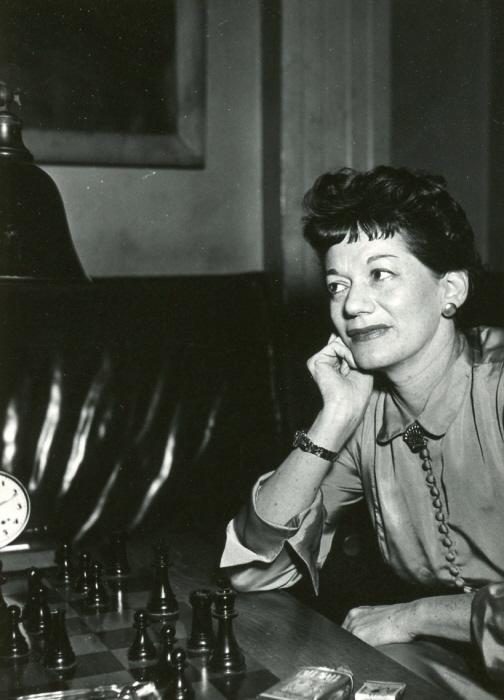
The Marshall Chess Club is currently cataloguing its photographic archives, and Alexander George (Amherst, MA, USA), who is on the club’s Board, submits the above photograph. Is it definitely, as believed, Lina/Lena Grumette, and can the picture be dated?
8174. ‘The most shattering experience’
An addition to the Royal Walkabouts article comes from Graham Clayton (South Windsor, NSW, Australia):
A.A. Murray – Floyd E. Hebert
Washington State Tourney, 1949
English Opening
1 c4 Nf6 2 Nc3 e6 3 e4 Nc6 4 d4 d5 5 e5 Ne4 6 Nf3 Bb4 7 Qc2 O-O 8 Bd3 f6 9 O-O Bxc3 10 bxc3 fxe5 11 dxe5 Ne7 12 Ba3 Rf4 13 Rad1 Qe8 14 Nd4 Nf5 15 Bxe4 Rxe4 16 Rfe1 Qh5 17 Rxe4 dxe4 18 Nxf5 exf5 19 Rd8+ Kf7 20 Qa4 c6 21 Qb4 Kg6 22 Qd6+ Kg5 23 g3 f4 24 Bc1 Kg4 25 Bxf4 Kh3 26 Rh8
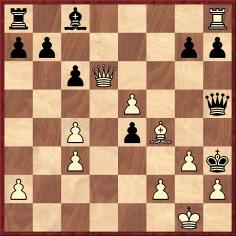
26...Bf5 27 Rxa8 Qf3 28 Kf1 Qh1+ 29 Ke2 Bg4+ 30 Ke3 Qf3+ 31 Kd4 Qd3+ 32 Kc5 b6+ 33 Kxc6 Qxc4+ 34 Kb7 Qf7+ 35 Kb8
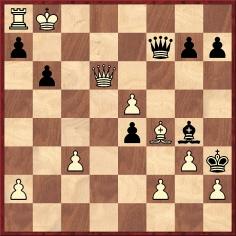
35...e3 36 Bxe3 Qe8+ 37 Kxa7 Qa4+ 38 Kb8 Qe8+ 39 Ka7 Qa4+ 40 Kxb6 Qxa8 41 a3 Qa4 42 Qb4 Qe8 43 Qb5 Qb8+ 44 Ka5 Qd8+ 45 Kb4 Qe7+ 46 Kb3 Be6+ 47 Kb2 Qd8 48 Kc1 Qa8 49 Qb4 Qh1+ 50 Kd2 Qd5+ 51 Ke2 Bg4+ 52 f3 Qxf3+ 53 Kd3 Qd5+ 54 Bd4 Bf5+ 55 Ke2 Qe4+ 56 Be3 Qc2+ 57 Kf3 Qd1+ 58 Kf4 Qg4 mate.
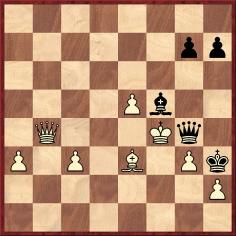
Source: Washington Chess Letter, August 1950, page 12.
A.A. Murray, who was the Games Editor, commented:
‘This game is the most shattering experience White has had at the chess board.’
8175. ‘Yanowsky v Toriran, Canada, 1953’ (C.N. 8116)
From page 78 of The Times Winning Moves 2 by Raymond Keene (London, 1996):
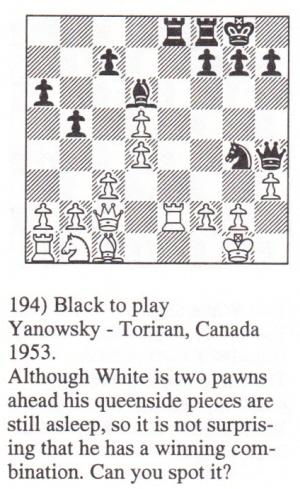
From page 57 of The Times Winning Moves by Raymond Keene and Byron Jacobs (London, 2003):
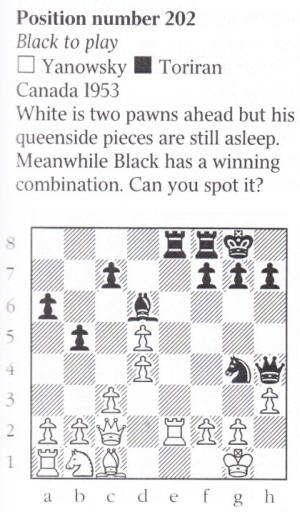
From Dan Scoones (Port Coquitlam, BC, Canada):
‘In citing a chess position it requires a very special talent to garble not only the venue and the date but also the surnames of both players – in other words, everything of significance apart from the actual position and the subsequent moves.’
Mr Scoones draws attention to the passage below from
page 116 of Chess the Hard Way! by D.A. Yanofsky
(London, 1953). ‘Hastings’ refers to the 1946-47
tournament, in which he came fourth.

We note ‘Yanofsky-Toriran, Canada, 1953’ on page 203 of the Encyclopaedia of Chess Middlegames (Belgrade, 1980), but the full game (Yanofsky v Tornerup, Copenhagen, 1947) was published on page 172 of CHESS, March 1947:

1 e4 e5 2 Nf3 Nc6 3 Bb5 a6 4 Ba4 Nf6 5 O-O Be7 6 Re1 b5 7 Bb3 O-O 8 c3 d5 9 exd5 e4 10 Ng5 Bd6 11 Nxe4 Nxe4 12 Rxe4 Bf5 13 Re3 Ne5 14 h3 Qh4 15 Bc2 Ng4 16 Re2 Bxc2 17 Qxc2 Rae8 18 d4 Qxf2+ 19 White resigns.
8176. Lipnitsky v Smirnov (C.N. 8160)
Alan McGowan (Waterloo, Canada) notes that Lipnitsky’s analysis was republished on pages 250-252 of the August 1952 Deutsche Schachzeitung. The 1949 Lipnitsky v Smirnov game was mentioned on page 251, the venue being specified as Kiev, 1949.

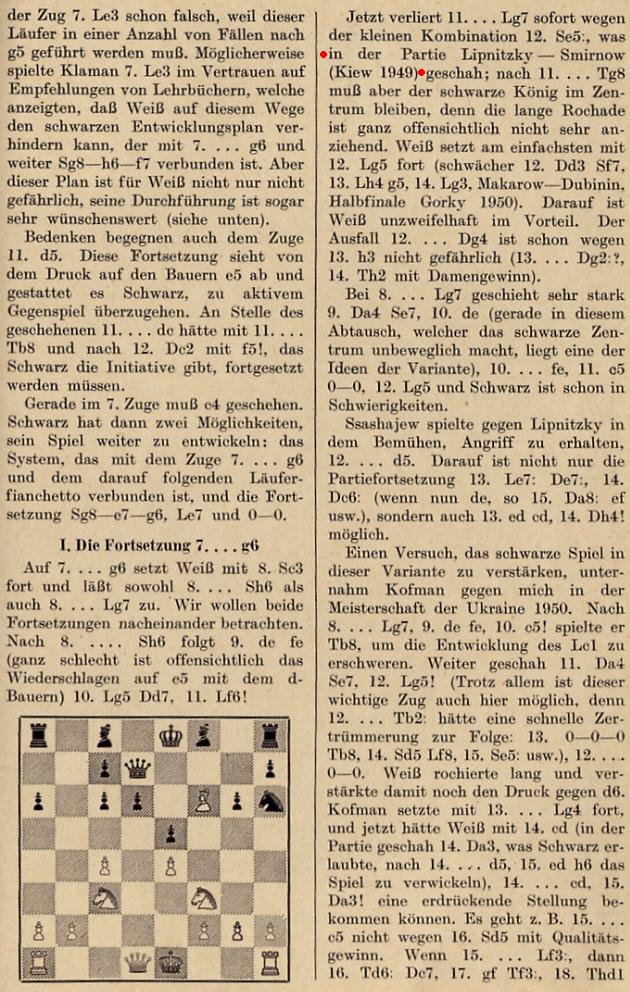
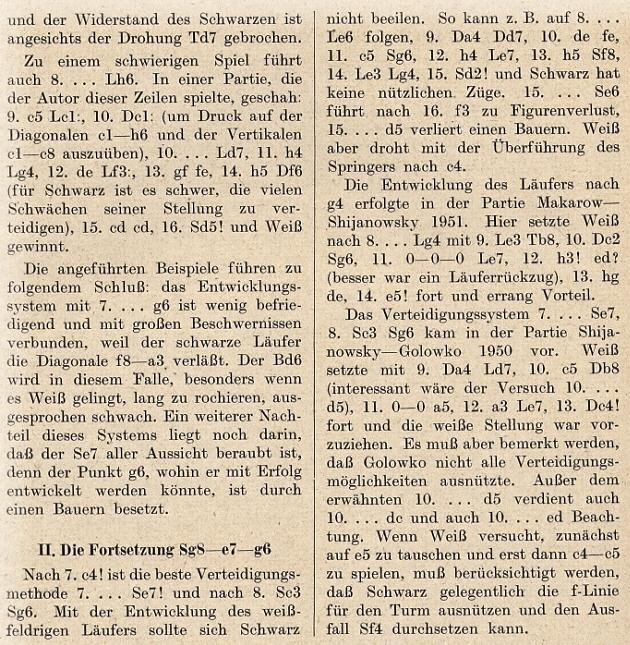
8177. Karpov v Korchnoi, Baguio City, 1978
Olimpiu G. Urcan (Singapore) draws attention to an impressive series of articles by Lim Kok Ann on the 1978 world championship match.
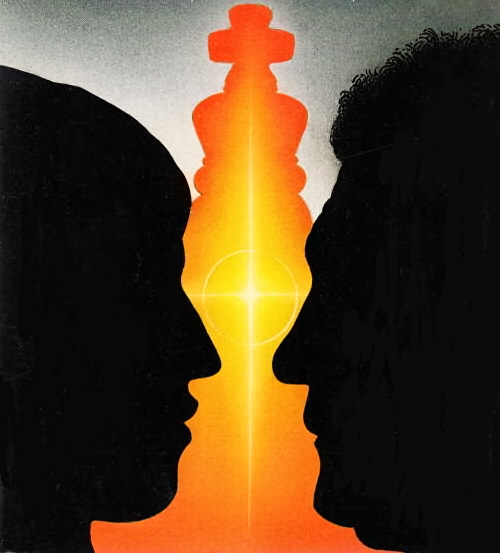
From the front cover of
the match book Het schaak der wrake
by H. Bouwmeester, J. van den Herik and L. Jongsma
(Utrecht/Antwerp, 1978)
8178. Photographs from the 1920s
Mr Urcan provides a copy of the photograph referred to in C.N. 4257 (Capablanca at the Café de la Régence in 1922), as well as others from the same newspaper:
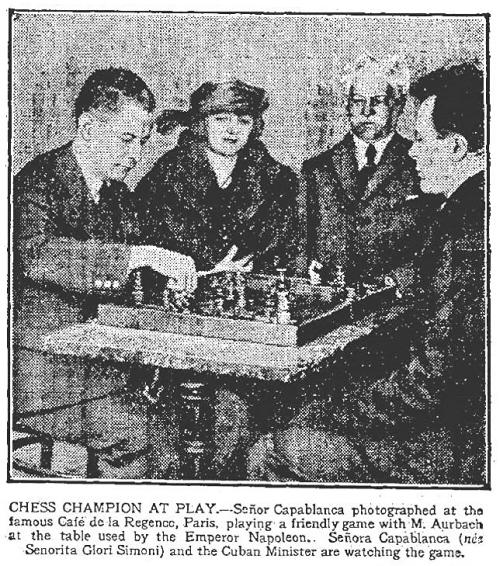
The Times, 30 March 1922, page 16

The Times , 17 August 1922, page 12

The Times, 12 April 1929, page 18.
As ever in such cases, information about copies of better quality will be appreciated.
8179. The gentle art of swindling
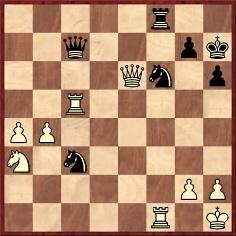
Black to move
‘If there was ever a position in which a player could resign with a clear conscience, here it is.’
So commented I.A. Horowitz and Fred Reinfeld in Chess Traps, Pitfalls, and Swindles (New York, 1954) in a discussion on pages 127-129:

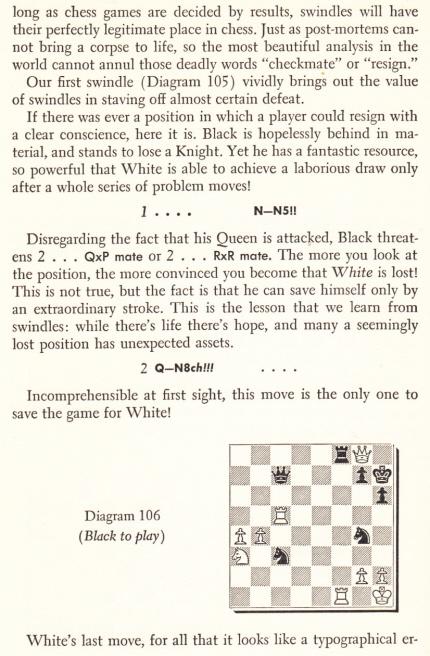
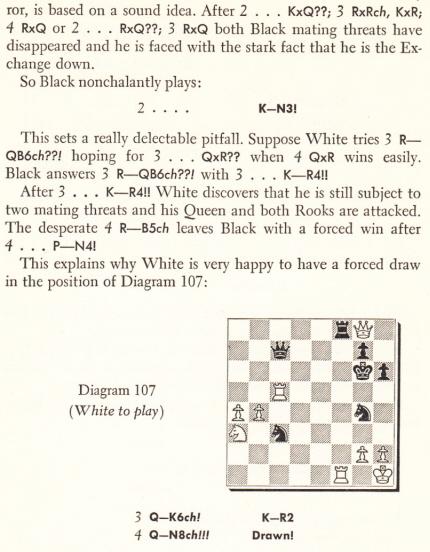
(Four lines above the diagram on the third page ‘4 R-B5ch’ means ‘4 R-QB5ch’.)
No information was provided about the players or occasion, but the following appeared on pages 107-108 of Kombinationen by Kurt Richter (Berlin and Leipzig, 1936):
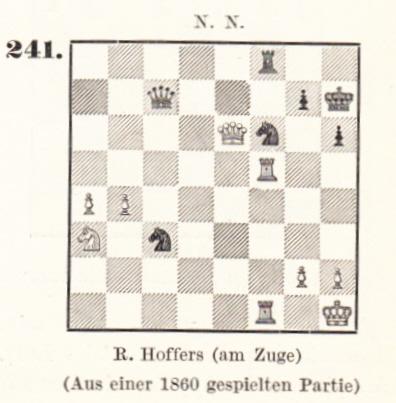
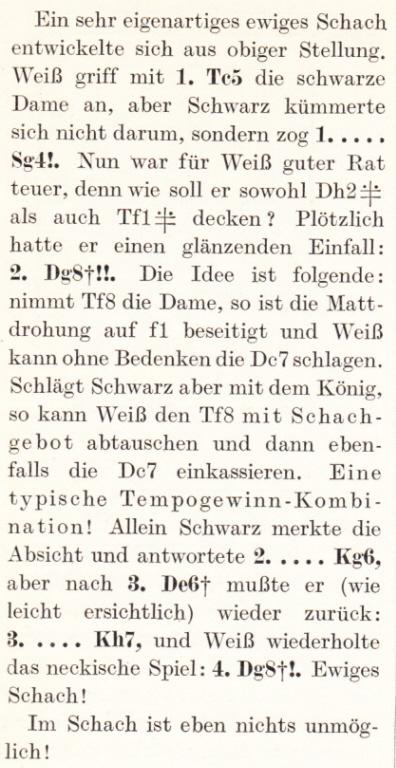
In later editions of Kombinationen it was position 271, but the information remained the same: Richter stated that R. Hoffers was White and that the game was played in 1860.
However, on page 119 of A Complete Guide to the Game of Chess by H.F.L. Meyer (London, 1882) R. Hoffers was named as Black, Dresden was given as the venue, and there was no date:

Below is the solution on page 122, in Meyer’s unwonted notation (explained in C.N. 4589):
Hoffers had also been identified as Black, not White, on page 313 of the October 1880 Deutsche Schachzeitung:

It is unclear exactly how the word ‘früher’ (e.g. ‘some time ago’) should be interpreted. Certainly, the references to Hoffers in the German magazine were clustered around 1880, and we have found nothing about him or the position in any publication circa 1860.
The conclusion was given on page 20 of the January 1881 Deutsche Schachzeitung:

Page 5 of the January 1880 issue had mentioned Hoffers in connection with the Schachverein Louis Paulsen, giving an address in Dresden (Strehlener Strasse 30):

Page 62 of the February 1882 Deutsche Schachzeitung printed a problem by ‘Rudolf Hoffers of Kamenz’ (Kamenz being a town about 40 kilometres from Dresden):
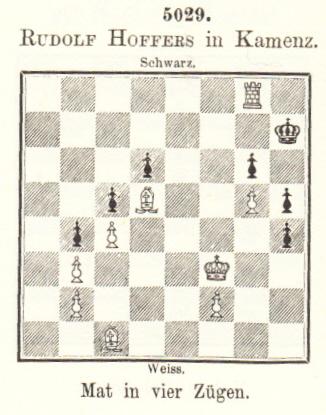
Inevitably, confusion has arisen between Hoffers and Hoffer. For example, page 42 of Chess Techniques by A.R.B. Thomas (London, 1975) labelled the ‘swindle’ position ‘Hoffer-N.N., 1860’.
Other occurrences in print are sought. What, for instance, was the source for the starting position given by Richter (with the white rook on f5 and not yet on c5)?
8180. ‘The most shattering experience’ (C.N. 8174)
On the basis of the US Public Records Index and the 1930 United States Federal Census (both available at Ancestry.com) Russell Miller (Vancouver, WA, USA) provides information on Arthur A. Murray, who was born on 28 June 1921 in Washington State.
8181. Lipnitsky v Smirnov (C.N.s 8160 & 8176)
Dan Scoones (Port Coquitlam, BC, Canada) forwards page 105 of the April 1952 issue of Shakhmaty v SSSR:
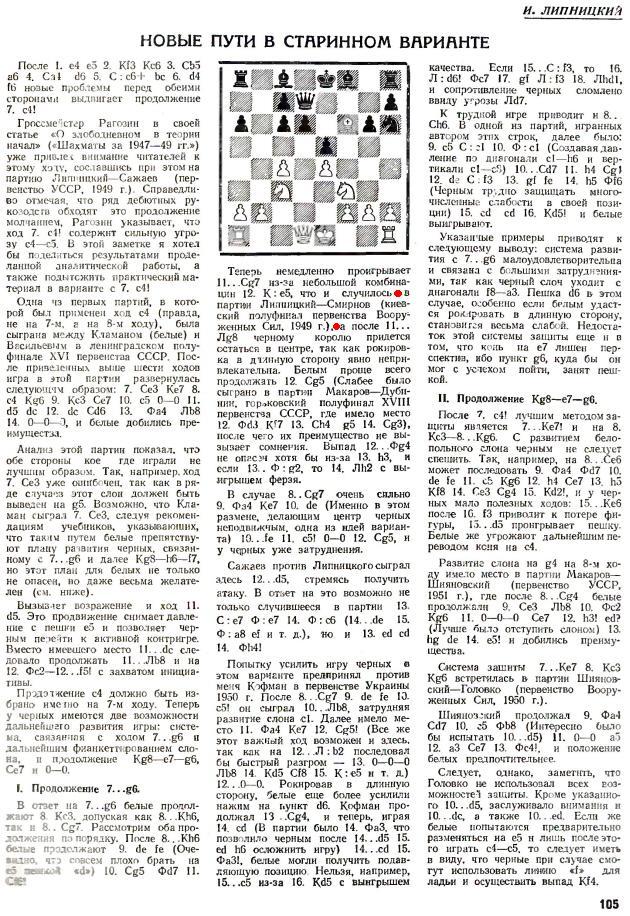
Just below the diagram there is a reference to the game Lipnitsky-Smirnov, played in the USSR Armed Forces Championship Semi-Final, Kiev, 1949.
8182. Capablanca at the Café de la Régence, 1922 (C.N.s 4257 & 8178)
From Christian Sánchez (Rosario, Argentina) comes an article by José A. Gelabert on pages 7 and 10 of El Demócrata (Mexico City), 22 March 1926. Our correspondent comments:
‘It is an account by the Cuban Minister in Paris, Rafael Martínez Ortiz, of Capablanca playing at Napoleon’s table. After a long anecdote in which a speaker mistook him for Capablanca, he relates that during the game a man dressed as Napoleon approached and that the scene was captured on film.’


8183. Good players are always lucky (C.N.s 5448 & 7691)
Another specimen of auctorial embroidery:
‘Some years later [after the game Mieses v Capablanca, Berlin, 1913] a disgruntled player at the Manhattan Club was complaining bitterly about a great position he had botched and remarked of his opponent, “He sure is lucky”. Capablanca smiled sagely and rejoined, “Good players are lucky”. He may have had this game in mind.’
Source: page 158 of Impact of Genius by R.E. Fauber (Seattle, 1992).
8184. Ståhlberg v Capablanca, Margate, 1936 (C.N. 8169)
C.N. 8169 quoted from pages 326-327 of CHESS, 14 May 1936:
‘Capablanca got into difficulties against Ståhlberg, but the latter ran short of time and decided to accept one of Capablanca’s offers to draw. Under the rule which stated that no game should be agreed drawn before 30 moves had been played by each side, the two contestants had to play on a further few moves before handing in their score-sheets. The play now became amusing, both players unconsciously relaxing; first Ståhlberg made a slip which would have lost a piece, and then Capablanca similarly made a move which allowed the possible gain of a pawn. Naturally these mistakes were not exploited since the agreement to draw had been reached. Readers may amuse themselves by looking for them.’
1 d4 Nf6 2 c4 e6 3 Nc3 d5 4 Nf3 Nbd7 5 Bg5 Be7 6 e3 O-O 7 Rc1 c6 8 Bd3 h6 9 Bh4 dxc4 10 Bxc4 b5 11 Bd3 a6 12 a4 bxa4 13 Nxa4 Qa5+ 14 Nd2 Bb4 15 Nc3 c5 16 Nb3 Qb6 17 dxc5 Bxc5 18 Nxc5 Qxc5 19 Bg3 Bb7 20 O-O Rfd8 21 Nb5 Qb4 22 Nd6 Bd5 23 e4 e5 24 exd5 Qxd6 25 Rc6 Qxd5
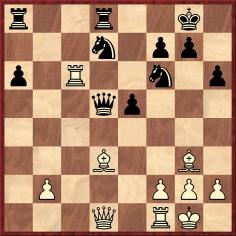
26 Rxa6 Rab8 27 Rd6 Qb7 28 Bf5 Qb5 29 Re1 Rb7
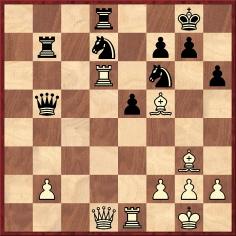
30 h3 Re8 Drawn.
As shown in C.N. 8169, page 159 of Schackvärlden, June 1936 stated that after 25...Qxd5 the players agreed to draw the game, although another five moves needed to be made. According to the magazine, Capablanca should have played 26...Rxa6 instead of 26...Rab8 ‘??’, and Ståhlberg could have won with 30 Bxe5.
The ‘Chess Stars’ book on Capablanca mentioned in our earlier item gave 26 Rxa6 a question mark, suggesting instead 26 Qc2 ‘!?’, with 27 Rd1 to follow. A question mark was also appended to 26...Rab8, the recommendation being 26...Nc5 ‘!’ 27 Rxf6 (if 27 Rxa8 Qxa8) 27...gxf6 28 Qg4+ Kf8, with a clear advantage to Black.
Instead of 30 h3 the book proposed 30 Bxe5 ‘!’ Re8 31 Bxf6 Rxe1+ 32 Qxe1 Qxf5 33 Bc3, with a clear advantage to White.
Schackvärlden commented on Ståhlberg’s gentlemanliness in adhering to the draw agreed earlier, but did he have a won game at any stage and, in particular, with Bxe5 at move 30? And how does all this tie in with the references in CHESS to Ståhlberg’s ‘slip which would have lost a piece’ and Capablanca’s ‘move which allowed the possible gain of a pawn’?
8185. Royal Literary Fund (C.N.s 7277, 7287 & 7288)
Olimpiu G. Urcan (Singapore) supplies the handwritten applications to the Royal Literary Fund submitted by G.H.D. Gossip and B. Horwitz.
8186. Showalter v Beckner
Mr Urcan also provides the game below, played in Kentucky, from page 32 of the Brooklyn Daily Eagle, 11 December 1930:
Jackson Whipps Showalter – John Taliaferro
Beckner
Georgetown, 1930 (?)
Ruy López
1 e4 e5 2 Nf3 Nc6 3 Bb5 d6 4 c3 Nf6 5 d4 Bd7 6 Qe2 Be7 7 Nbd2 exd4 8 cxd4 O-O 9 O-O Re8 10 Rd1 a6 11 Bc4 Bg4 12 Nf1 d5 13 exd5 Nxd5 14 Qe4 Nf6 15 Qd3 Qd7 16 Ng3 Bd6 17 Bg5 Nh5 18 Ne4 Bf5 19 Re1 Bf4 20 g3 Bxg5 21 Nfxg5 Bg6 22 Rad1 Rad8 23 Qc3 h6 24 Nc5 Rxe1+ 25 Qxe1 Qg4
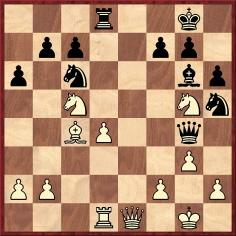
26 Nge6 Re8 27 Be2 Qf5 28 g4 Qf6 29 gxh5 Bf5 30 Nxc7 Qg5+ 31 Kh1 Bh3 32 Qg1 Rxe2 33 Qxg5 hxg5 34 d5 Ne5 35 d6 Rxf2 36 d7 Bxd7 37 Kg1 Rc2 38 Nxd7 Nf3+ 39 Kf1 Nxh2+ 40 Kg1 Nf3+ 41 Kf1 Rxc7 42 White resigns.
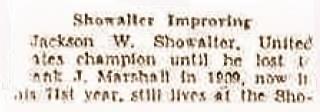

An earlier game between the two players was given in C.N. 7216.
8187. Amaurosis scachistica
When was the first occurrence in print of Tarrasch’s term ‘amaurosis scachistica’ (chess blindness)?
The phrase was in the title of an article at the end (pages 452-455) of his book Die moderne Schachpartie (various editions, of which the first was published in 1912):
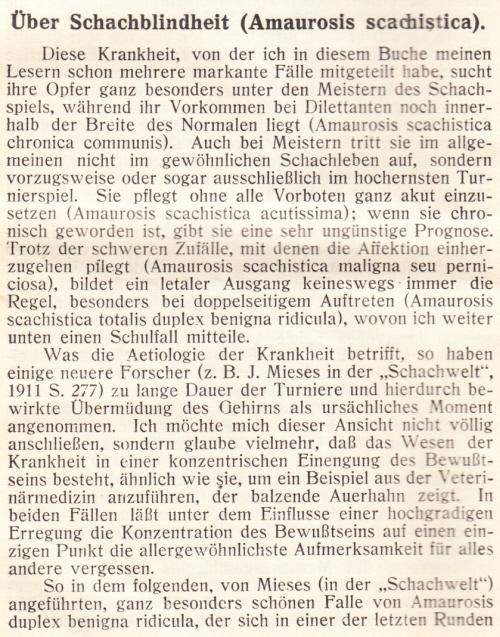



From the Preface to the first edition (page ix):

Is it possible to identify the newspaper in which the article on ‘amaurosis scachistica’ originally appeared?
Tarrasch republished the article, with minor rewording, on pages 337-340 of Tarrasch’s Schachzeitung, 1 September 1933.
As regards English-language publications, the Latin term was mentioned in a review of Die moderne Schachpartie on page 159 of the July 1913 American Chess Bulletin, although rendered as ‘amaurosis schachistica’. An oft-seen spelling is ‘amaurosis scacchistica’, e.g. on page 174 of All About Chess by I.A. Horowitz (New York, 1971).
8188. ‘A Chess Talk with Lasker the Champion’
Patsy A. D’Eramo (North East, MD, USA) forwards page 4 of the San Francisco Chronicle, 11 January 1903, comprising a lengthy article entitled ‘A Chess Talk with Lasker the Champion’.
Among the interesting material is an explanation of a game invented by him, checkerette, and the following comments on chess:
‘I am sorry to say that I do not much care whether I win or not now.’
‘At present a stalemate is regarded as a drawn game. Undoubtedly it will soon be considered a victory for the player who places his opponent in such a position.’
The newspaper also reproduced a Troitzky study in Lasker’s hand:
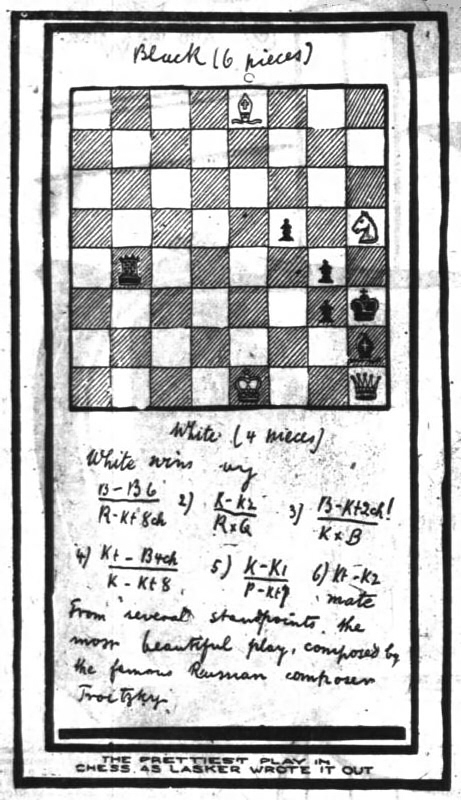
The composition, dated 1897 and with the knight on g6 instead of h5, is on pages 69-70 of Collection of Chess Studies by A.A. Troitzky (Leeds, 1937).
8189. Ståhlberg v Capablanca, Margate, 1936 (C.N.s 8169 & 8184)
From Yasser Seirawan (St Louis, MO, USA):
‘An amusing comedy of errors, to be sure. It seems quite dangerous to agree to a draw and then play on to a specified number of moves before stopping.
Certainly, 26 Rxa6 was a bad error, and with 26...Nc5 Capablanca could have turned the tables decisively.
The immediate 26 Rd6 would still allow White to keep some advantage.
The favor was returned immediately by 26...Rab8, a bad move because 26...Nc5 is so much better.
Instead of 27...Qb7 (?!), either 27...Qc5 or 27...Qa5 would be better. The disadvantage of 27...Qb7 is that the queen does not protect the d8 rook, which makes the pin on the d-file hard to disentangle.
After falling into a terrifying pin on the d-file Black would seem lost. Although the suggestion 30 Bxe5 is a fine one, I think that 30 Rxe5 is far stronger, as Black is then tied and tethered. The critical continuation seems to be 30...Qxb2 31 Re1, when the solution to Black’s problem of the d-file pin remains a mystery to me.’
8190. Simultaneous display by Sultan Khan
Olimpiu G. Urcan (Singapore) sends this report by Louis van Vliet in the Sunday Times, 29 September 1929, page 21:
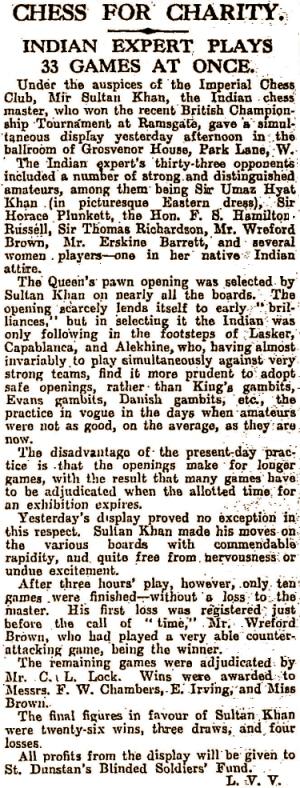
Our correspondent also provides a game-score from page 4 of the newspaper’s 6 October 1929 edition:
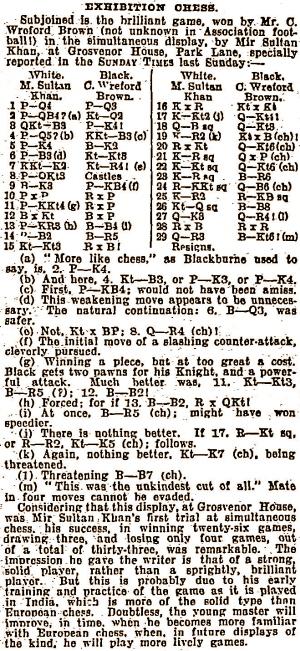
Sultan Khan – Charles Wreford Brown
London, 28 September 1929
Old Indian Defence
1 d4 d6 2 c4 Nd7 3 Nc3 e5 4 d5 Ngf6 5 e4 Be7 6 f3 Nb6 7 Nge2 Nh5 8 b3 O-O 9 Be3 f5 10 exf5

10...Rxf5 11 g4 Rxf3 12 Bxb6 Bxg4 13 h3 Bf5 14 Bf2 Bh4 15 Ng3 Rxf2 16 Kxf2 Nxg3 17 Kg2 Qg5 18 Qc1 Qg6 19 Kh2 Nxf1+ 20 Rxf1 Qg3+ 21 Kh1 Qxh3+ 22 Kg1 Qg3+ 23 Kh1

23...Bh3 24 Rg1 Qf3+ 25 Kh2 Rf8 26 Nd1 Bf1 27 Qe3 Qh5 28 Rxf1 Rxf1 29 Qh3 Bg3+ 30 White resigns.
The display, organized by Mrs Arthur Rawson of the Imperial Chess Club, was also reported on page 422 of the November 1929 BCM and on page 27 of the November 1929 Chess Amateur.
8191. Stormy petrels
C.N. 2194 (see page 134 of A Chess Omnibus) quoted from page 574 of the March 1882 issue of Brentano’s Chess Monthly a reference to P. Richardson being named ‘The Stormy Petrel’ by G.H. Mackenzie. See too Philip Richardson The Stormy Petrel of Chess by John S. Hilbert (Olomouc, 2009).
The description ‘stormy petrel’ in connection with Nimzowitsch is on page v of My System (London, 1929), at the start of the Translator’s Preface. The translator was Arthur Hereford Wykeham George, using the pseudonym Philip Hereford (BCM, July 1937, page 361).
The relevant text also appeared on the front of the dust-jacket and in advertising material, such as the following on page 45 of the November 1929 Chess Amateur:
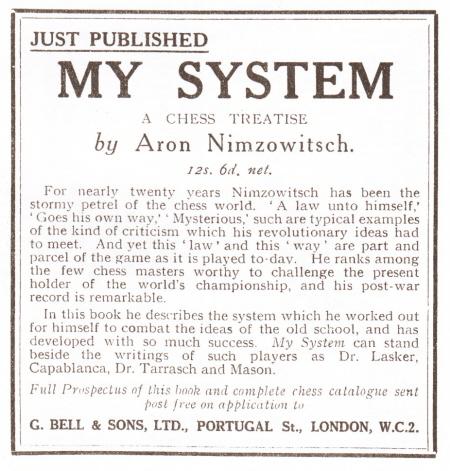
Have any other languages taken up a name such as ‘stormy petrel’ in connection with Nimzowitsch, Richardson or any other player?
8192. Botvinnik spoke out
‘As far as Garik [Kasparov] was concerned, I immediately came to blows with him. For he first made a move and only then thought about it. While the proper order is, as you know, exactly the other way around. “Watch out”, I used to say to him, “if you go on like this you’ll become a Taimanov or a Larsen, Garik.” These two were the same, even when they were grandmasters – first move, then think.’
Christian Sánchez (Rosario, Argentina) quotes the above remark by Botvinnik from page 40 of the 0/1984 issue of New in Chess (in a feature, ‘Botvinnik speaks out’, on pages 36-43).

At the time (in C.N. 825) we commented about New in Chess:
The highlight of issue zero is a most extraordinary interview with Botvinnik. Our eye homed in on a quote, ‘Capablanca was a genius, the greatest genius in the whole history of chess’, and we at once felt well-disposed to the former world champion, ‘Mr Soviet Chess’. But the rest of the material makes Botvinnik a difficult man to like, the interview being a supreme example of high bitchery.
Karpov is ‘an exploiter of other people’s ideas. His ability to use these ideas is not at issue, but he himself is about as fertile as a woman who has been sterilized’. Portisch and Polugayevsky ‘have no talent for real research’. Balashov ‘is dull-witted. When he comes into unknown territory he is as defenseless as a kitten’. Karpov ‘cannot just force Roshal, who writes all his books for him, to develop a new chess idea for him’. Kasparov’s games ‘are the only ones I still play over’. ‘I hardly talk to the grandmasters here anymore. Nor to the Chess Federation of the USSR.’
... Certainly Botvinnik adopts a most surprising anti-Soviet stance, and even makes a point of mentioning the dreaded Korchnoi: ‘Of the top chessplayers of the moment I would like to mention two names: Korchnoi and Kasparov.’ He even permits himself an analysis of Karpov’s divorce: ‘It was not a real divorce. She just left him. When two people are not in love they separate automatically.’
Up until a few years ago Botvinnik was a dull case for historians, psychologists, etc., but his recent writings and interviews reveal an unknown, or neglected, side of his character. The interview is an amazing document, and a memorable scoop for New in Chess.
8193. Chess in the Daily Mail
Olimpiu G. Urcan (Singapore) has forwarded a number of chess items published in the Daily Mail in the 1920s and 1930s:

Daily Mail, 7 August 1922, page 6

Daily Mail (Atlantic Edition), 12 November 1925, page 3

Daily Mail, 16 November 1928, page 17
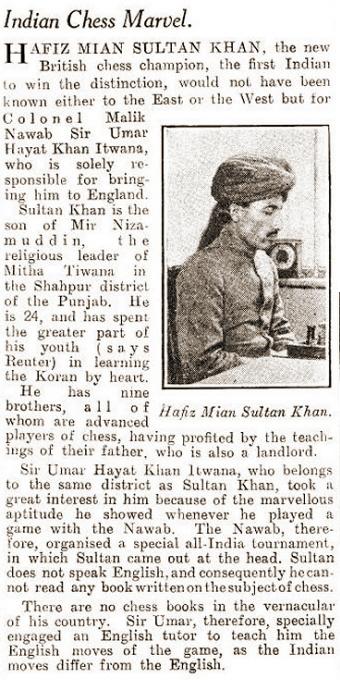
Daily Mail, 28 September 1929, page 5

Daily Mail, 6 January 1931, page 7

Daily Mail, 17 August 1932, page 5
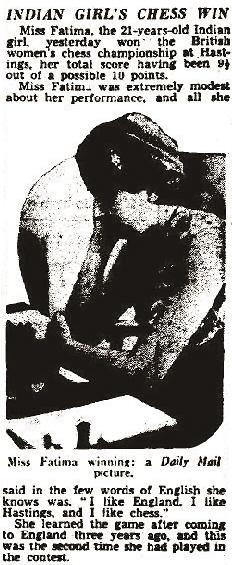
Daily Mail, 11 August 1933, page 7

Daily Mail, 24 January 1938, page 7.
8194. White and Black
An example of Gerald Abrahams’ unmistakable prose style as he tackles a complex topic:
‘... The author ventures the suggestion that there is a lot of nervousness among the players of Black – a nervousness which is unjustified.
If White is a better colour than Black, then let us all give up chess!
What is the truth of the matter? First, White has an initiative. In certain well-recognized lines of play, which Black may feel it necessary to adopt (e.g. defences to the López), that initiative lasts a long time. But an initiative must not be confused with an advantage.
There is no opening in which White, without sacrificing unsoundly, can prevent Black achieving full development. When that is achieved, it may well be a better development than White’s, because it is a subtler one; in the interstices of a rigid position.
But Black must be patient; and Black has more work to do in the early stages, while White has a few more possibilities in his field of choice. Players, therefore, prefer White through laziness. They prefer not to have to work too hard in the opening stages. But in reality White too must work. To preserve an initiative as long as possible, without incurring strategic commitments that may prove undesirable, is at least as hard a task as playing a process of development without full initiative. There are a few players, the author included, who actually like Black, precisely because the play for “equalization” is there to be found, and find its exploitation fascinating. Two propositions, certainly, are true: (1) Nobody ever beat a better player through having White. (2) Nobody ever lost merely through having Black. If it be said that White can so play as to have drawing chances against the best, the answer is: play against the best – and see!’
Source: page 275 of The Handbook of Chess and The Pan Book of Chess by Gerald Abrahams (London, 1965).
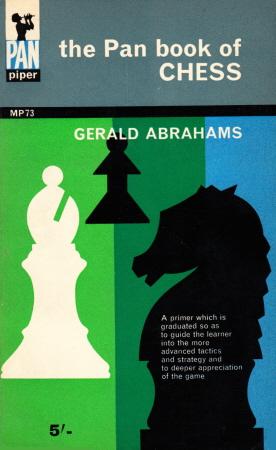
8195. Who? (C.N. 8172)
The sketch came from the front cover of Torneo de Nottingham 1936 by Luis de Marimón and Julio Ganzo (Madrid, 1957):
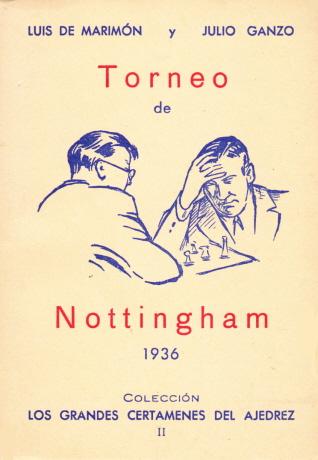
It would seem that identification of the players can only be guesswork.
8196. Influential books
Asked about chess books which had a profound influence on him, John Nunn replied (see the 3/2002 New in Chess, page 98):
‘When I was a young player, I read The Most Instructive Games of Chess Ever Played by Irving Chernev which made chess seem extremely easy. However, I then read Alekhine’s Best Games of Chess, which made chess seem impossibly difficult. I eventually discovered that the truth lies somewhere between the two.’
Dr Nunn informs us:
‘I was referring to the 1924-37 volume by Alekhine. I recall being particularly impressed by 18...Nxf2 in Rubinstein v Alekhine, Semmering, 1926, or rather the fact that Alekhine must have seen it some time in advance.’
Most C.N. items mentioning Irving Chernev have concerned chess history and lore, but he was an exceptionally entertaining annotator. The Most Instructive Games of Chess Ever Played was published by Simon and Schuster, New York in 1965 and by Faber and Faber, London the following year. The US publishers also brought out a Fireside paperback edition (undated), and in 1992 the work was reprinted by Dover Publications, Inc., New York. An algebraic version has yet to be produced and would be very welcome.
8197. Tarrasch v Vogel
Game 45 in Chernev’s The Most Instructive Games of Chess Ever Played is ‘S. Tarrasch-S. Vogel, Nuremberg, 1910’. Under the heading ‘The Galloping Knight’, it is described as ‘superb position play by a master in that domain’.
The game was the second of three (numbers 4, 7 and 114) between the two players in Tarrasch’s Die moderne Schachpartie (first published in 1912). All were played in Nuremberg, game 4 in 1910 and game 114 in 1909. Tarrasch provided no details regarding the occasion, and in each case his opponent was named only as ‘Herr Vogel’. On the other hand, when two of the encounters were given in Tarrasch’s Best Games of Chess by Fred Reinfeld (London, 1947) Black was named as ‘S. Vogel’ each time.
It is unclear whether Tarrasch’s opponent was the Vogel who participated in a tournament in Nuremberg in 1888 (Deutsche Schachzeitung, September 1888, pages 262 and 265). No other information about him was given there beyond ‘Vogel (Nürnberg)’.
In its 1909 volume the Deutsche Schachzeitung had a few references to J. Vogel of Nuremberg. See too page 272 of Deutsches Wochenschach, 8 August 1909. A game Vogel v W. Schmidt from the ‘Hauptturnier zu Nürnberg’ was published on pages 133-134 of Schachjahrbuch für 1909 by Ludwig Bachmann (Ansbach, 1909):
1 e4 e6 2 d4 d5 3 exd5 exd5 4 Nf3 Nf6 5 c4 c6 6 Nc3 Bb4 7 Bd3 O-O 8 O-O Bg4 9 Bg5 Nbd7 10 Qc2 Qc7 11 cxd5 Bxf3 12 gxf3 Bxc3 13 bxc3 cxd5 14 Kh1 h6 15 Bd2 Kh8 16 Rg1 Ng8 17 Rg3 Ndf6 18 Rag1 Nh5 19 Rg4 f5 20 Rh4 Qf7 21 Qc1 Rac8 22 Qf1 g6 23 Qh3 Kh7 24 Qg2 Ngf6 25 Qh3 Ng8
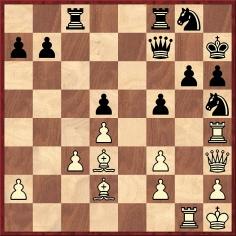
26 Rxg6 Qxg6 27 Rxh5 Kg7 28 Rxf5 Rc6 29 Rg5 hxg5 30 Bxg6 Kxg6 31 Qg4 Rf5 32 h4 Nf6 33 Qg2 Nh7 34 f4 Ra6 35 hxg5 Rxa2 36 Be3 a5 37 Qh3 Nf8 38 Qh6+ Kf7 39 Qb6 Ra1+ 40 Kg2 Ra3 41 Qb2 Ra4

42 Qc2 Resigns.
The Ehrentafel (roll of honour) on page 421 of the 27 December 1914 Deutsches Wochenschach listed under the Schachklub Noris of Nuremberg: ‘Vogel, Johann, Kaufmann†’. Johann Vogel was also named on pages 59-60 of the February 1915 Deutsche Schachzeitung as being among those who had ‘fallen on the field of honour’ (‘auf dem Felde der Ehre sind gefallen’). The Ehrentafel on page 259 of Schachjahrbuch für 1914. II Teil by L. Bachmann (Ansbach, 1914) included ‘Vogel, Johann, Nürnberg’. Page 20 of the January-February 1915 Wiener Schachzeitung reported: ‘Hans Vogel vom Schach-Klub “Noris” in Nürnberg ist auf dem Felde der Ehre gefallen.’
Can readers help us to build on these preliminary findings?
8198. Arthur Tartakower
Another early victim of the Great War was a younger brother of Savielly Tartakower, Arthur, as reported on page 58 of the February 1915 Deutsche Schachzeitung:
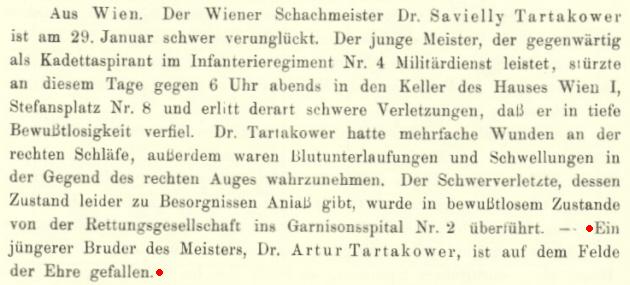
Further details about him were given on page 24 of the January 1918 issue:

As recorded on page 23 of the Hamburg, 1910 tournament book, Arthur Tartakower finished in the middle of group five of the Hauptturnier B. His defeat of the joint winner, ‘Jankowitsch’ (Boris Yankovich), was given on pages 169-170:
1 e4 e5 2 Bc4 Nf6 3 d3 Bc5 4 Nc3 d6 5 f4 Bxg1 6 Rxg1 Bg4 7 Qd2 exf4 8 Qxf4 Nbd7 9 h3 Bh5 10 g4 Bg6 11 h4 h5 12 g5 Ng4 13 Bd2 Nge5 14 O-O-O a6 15 Be3 O-O 16 Bb3 Ng4 17 Rxg4 hxg4 18 Qxg4 Ne5 19 Qe2 Kh8 20 d4 Nc6 21 h5 Bh7 22 g6 Bg8 23 Qh2 Na5
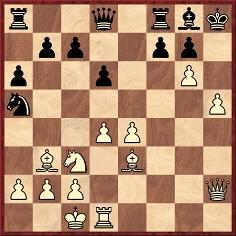
24 h6 Nxb3+ 25 axb3 Qd7 26 hxg7+ Kxg7 27 Bh6+ Kf6 28 Qh4+ Ke6 29 d5+ Ke5 30 Qf4 mate.
Unsurprisingly, the FatBase database ascribed the victory to Savielly Tartakower.
8199. Ernest Harrod
From page 38 of CHESS, 29 October 1955, concerning the Postal Chess Club:

What is to be made of the reference to Capablanca?
8200. Stolen and marred in the stealing
‘Discreditable conduct in taking without leave or acknowledgement the work of other men; defacing their work by his clumsy, muddling alterations.’
Such was the reaction to a small chess volume (weight: 20 grams) published by the British Chess Federation, The Laws of Chess (Stroud, 1912), the main culprit being William Ward of the City of London Chess Club. His aim had been to produce a simplified version of The British Chess Code, and it was one of the chief contributors to that Code, E.E. Cunnington, who instigated a barrage of criticism of The Laws of Chess, on pages 4 and 6 of the Chess Amateur, October 1912. For instance:
‘§11 is a “gulf of obscurity”. The king is “said to be in check if he be (meaning ‘is’) in such a position that, but for this law, he would be liable to capture, or would be so liable but for the fact that if the capture were made the adverse king would be left in check”. We may be dull, but this is Chinese to us.’
Cunnington’s concluding salvo:
‘The proper title of Mr Ward’s work is “The British Chess Code mutilated and marred by W. Ward”.’
A new feature article, The Laws of Chess (1912), reproduces the text from the booklet, as well as E.E. Cunnington’s critique and other material from the Chess Amateur.
8201. Film footage
Thomas Höpfl (Schkopau, Germany) and Dan Scoones (Port Coquitlam, BC, Canada) point out a video item featuring Euwe and Alekhine (1935) which is similar, but not identical, to one available in Chess Masters on Film.
From Thomas Höpfli there also comes a link to a video report on Arturo Pomar which includes Fischer speaking a few words of Spanish.
8202. A.J. Mackenzie
The references in C.N. 8165 and 8167 to A.J. Mackenzie, the controller at Nottingham, 1936, prompt us to give a specimen of his play. It was published on pages 86-87 of the January 1930 Chess Amateur, annotated by W.A. Fairhurst:
Arthur John Mackenzie (Birmingham) – F. Schofield
(Leeds)
Sheffield, 2 December 1929
Budapest Defence
1 d4 Nf6 2 c4 e5 3 dxe5 Ng4 4 e4 Nxe5 5 f4 Ng6 6 Nf3 Bb4+ 7 Bd2 Qe7

8 g3 Qxe4+ 9 Kf2 Bc5+ 10 Kg2 O-O 11 Nc3 Qf5 12 Nd5 d6 13 h4 Qd7 14 h5 Ne7 15 h6 Nxd5 16 hxg7 Ne3+ 17 Bxe3 Kxg7 18 Bd4+ Bxd4 19 Qxd4+ f6 20 Bd3 h6

21 Rxh6 Kxh6 22 Rh1+ Kg7 23 Rh7+ Kg8 24 Rxd7 Nxd7 25 Qd5+ Kg7 26 Qh5 Rh8 27 Qg6+ Kf8 28 Nd4 Nc5 29 Qxf6+ Kg8 30 Qd8+ Kg7 31 Qxc7+ Bd7 32 Bf5 Rhd8 33 Kf2 Rac8 34 Qxd6 Bxf5
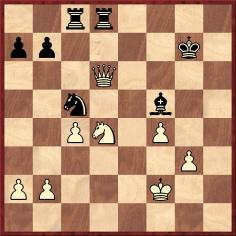
‘White announced mate in six moves.’
8203. Alekhine in the Netherlands
In chess lore and history there is often an easy/lazy way and a difficult/worthwhile way, and this is illustrated by an Alekhine position indirectly referred to in C.N. 8116. From page 33 of The Times Winning Moves by R. Keene and B. Jacobs (London, 2003):

The solution on page 139:

Nothing could be less toilsome than making such straight use of game 120 in the second volume of Alekhine’s Best Games:
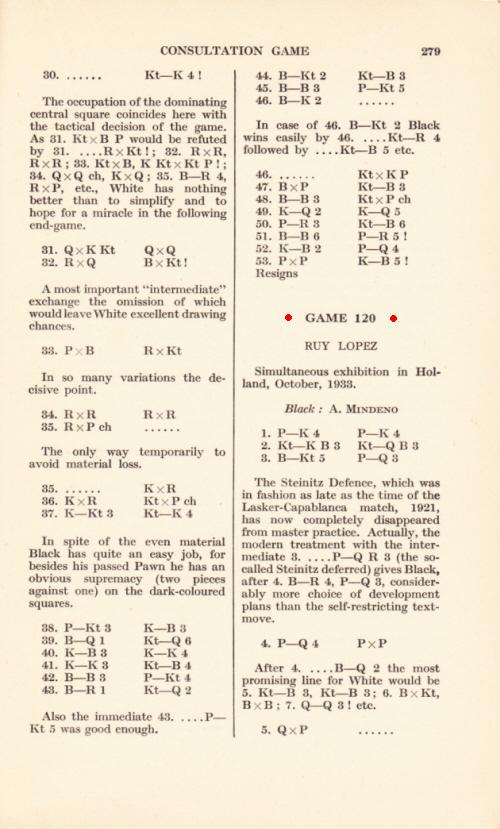


But then there is the difficult/worthwhile way, which entails trying to keep abreast of research, presenting the known facts accurately and endeavouring to establish the truth.
The game was published, with Black unidentified, in a report in the Tijdschrift van den Nederlandschen Schaakbond, November 1933. Below are the relevant parts, from pages 296-297:

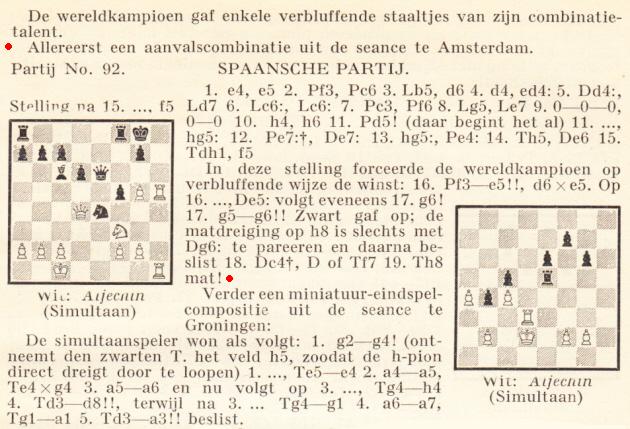
Black was also left anonymous on pages 86-87 of Tarrasch’s Schachzeitung, 15 December 1933:
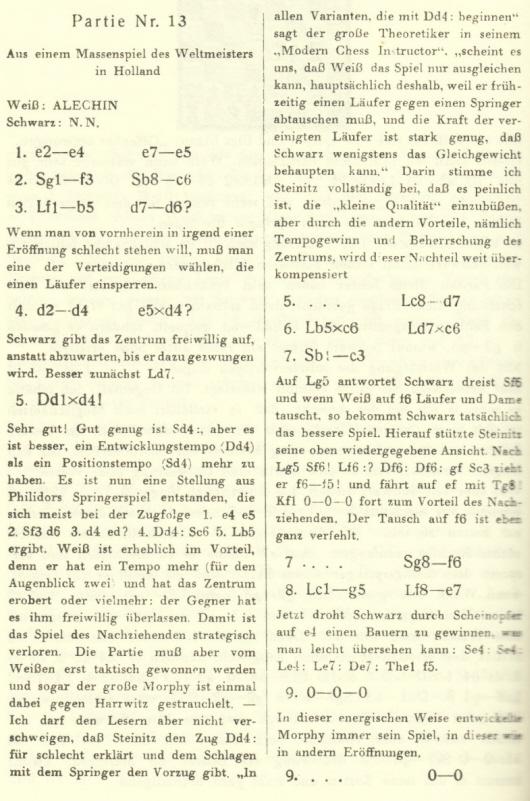
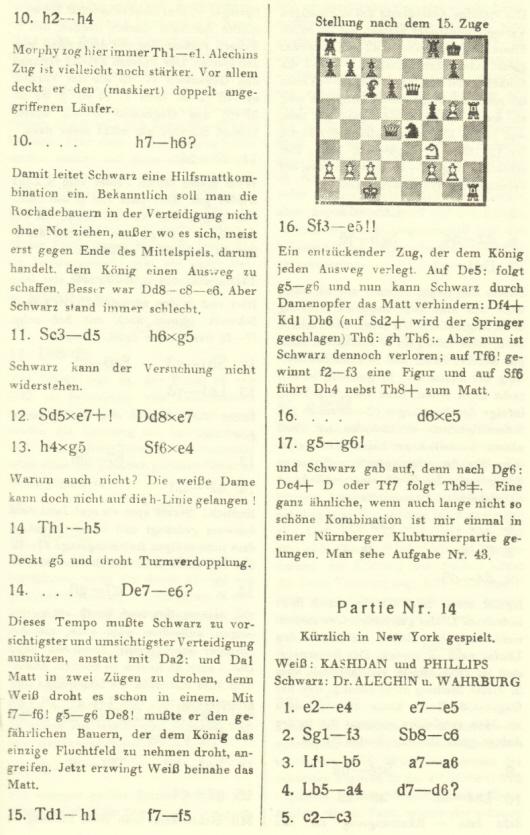
In 1988 (C.N.1544) we asked why Black was named as Hulscher, and not Mindeno, when the game was given (with, moreover, a different move order) on page 152 of the November 1933 American Chess Bulletin:
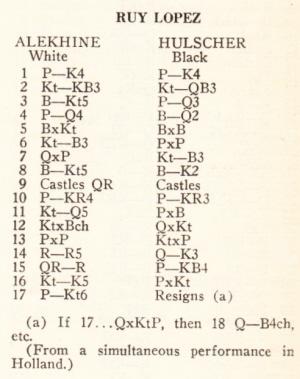
Our question was taken up by Tony Mantia in an article on page 18 of the 22/1992 issue of Inside Chess:

So now there was a third name, Hoelsder. The following comes from pages 90-91 of Alekhine in Europe and Asia by J. Donaldson, N. Minev and Y. Seirawan (Seattle, 1993):
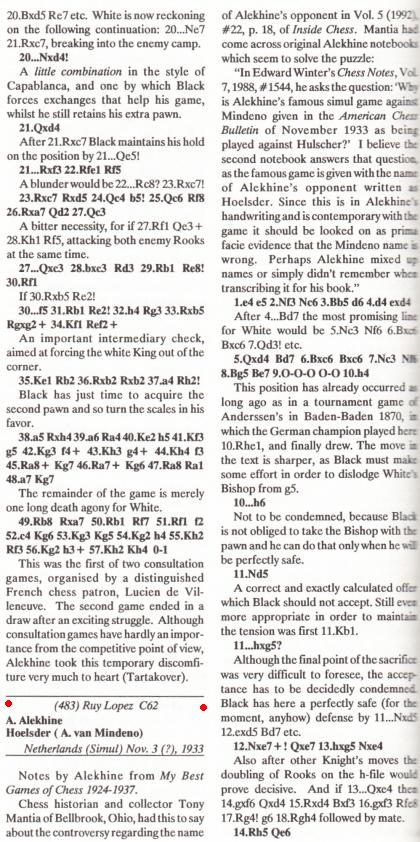
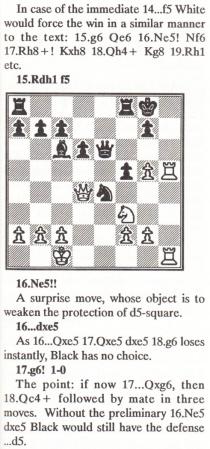
On the other hand, ‘Alekhine-Hulscher’ was given by Leonard M. Skinner and Robert G.P. Verhoeven on page 476 of Alexander Alekhine’s Chess Games, 1902-1946 (Jefferson, 1998), on the grounds that the name Hulscher appeared in the Nieuwe Rotterdamsche Courant, 7 November 1933:
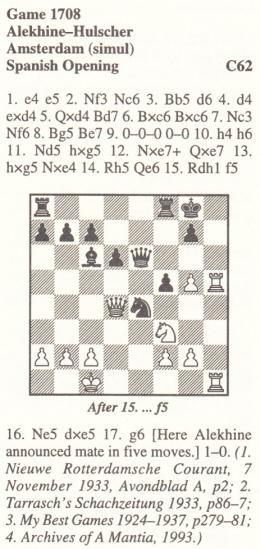
As regards the above reference to ‘Archives of A. Mantia, 1993’, we are grateful to Dr Skinner for sending us a copy of the relevant part of Alekhine’s notebook, and to Mr Mantia for permission to show it here:
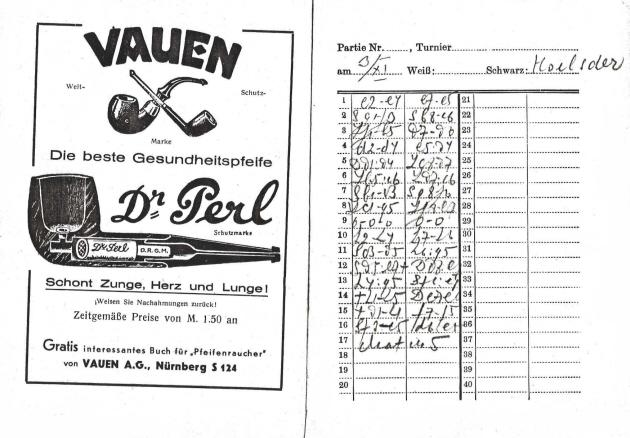
On the analytical front too there are complications, as mentioned in C.N. 1027, which referred to CHESS, August 1975, page 328, and the BCM, February 1983, page 69. Furthermore, the game was discussed by E. Böök on page 82 of the December 1947 CHESS and on page 151 of the March 1948 issue:
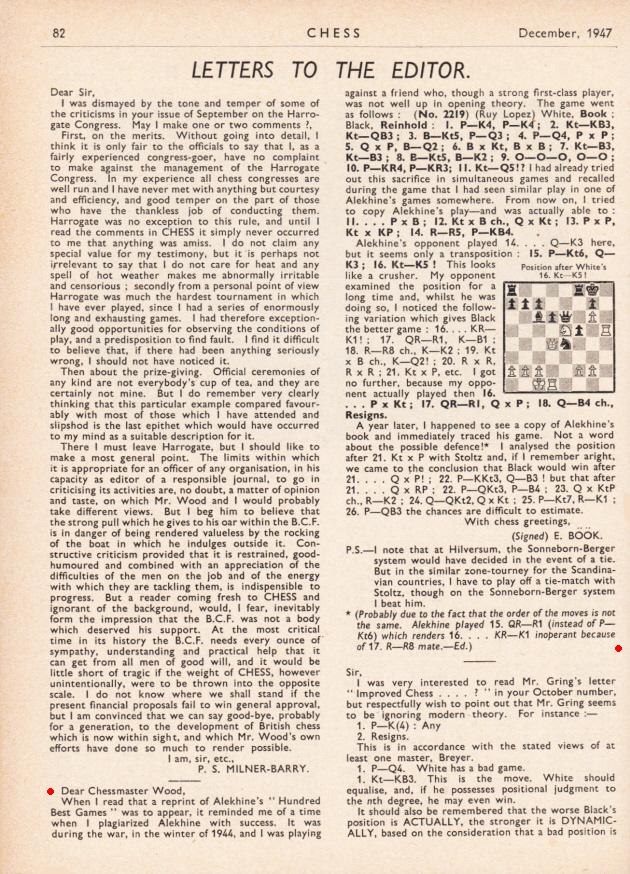
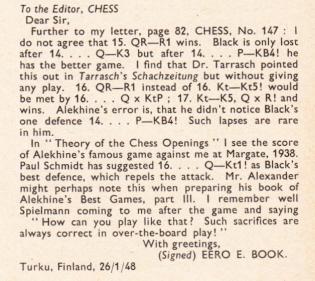
See, however, Tarrasch’s note to 14...Qe6, given earlier in the present item. We add that Böök’s account was discussed on pages 120-122 of The Pleasures of Chess by Assiac (New York, 1952).
At present, no tidy conclusions seem possible about the identity of Alekhine’s opponent, beyond the observation that, for the past two decades, competent writers have not named him unquestioningly as Mindeno.
8204. Szachy wojenne 1939-1945 War chess

Paweł Dudziński (Ostrów Wielkopolski, Poland) has sent us
a copy of his book Szachy wojenne 1939-1945 War chess
(Ostrów Wielkopolski, 2013). Richly illustrated with
games, photographs and documents, the historical narrative
is remarkably detailed. The work is a 299-page soft-cover
publication in Polish, with a summary in English on pages
273-277.
A sample page, although one of the lighter ones:
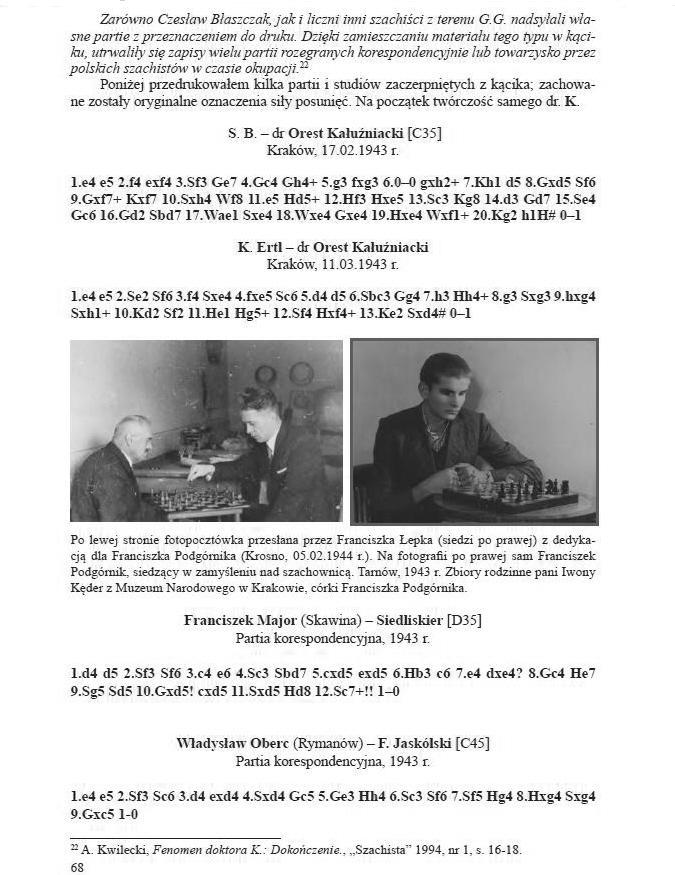
Mr Dudziński has authorized us to reproduce here a number of photographs, and the scans provided by him are accompanied below by the book’s captions.
From page 76:


From page 185:

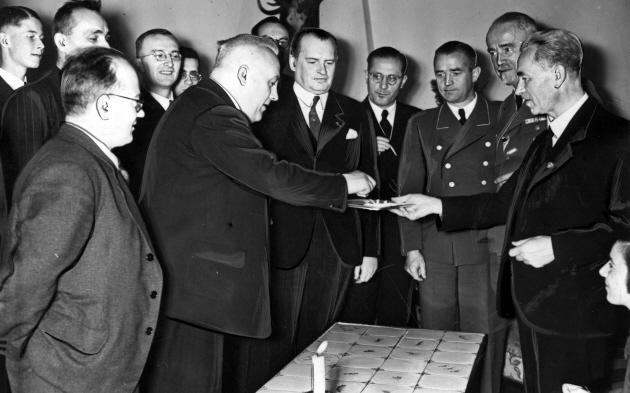

From page 187:
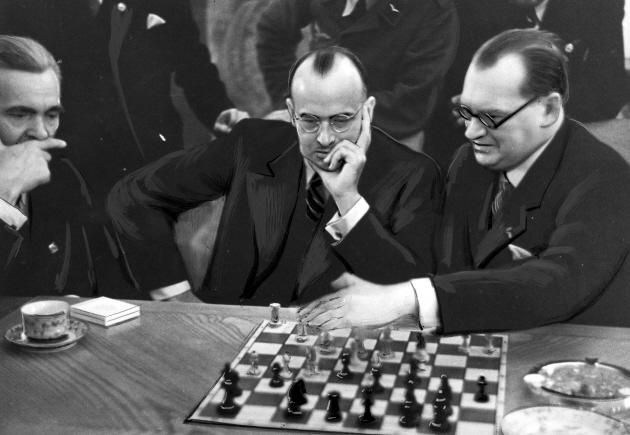

From page 192:


From page 193:
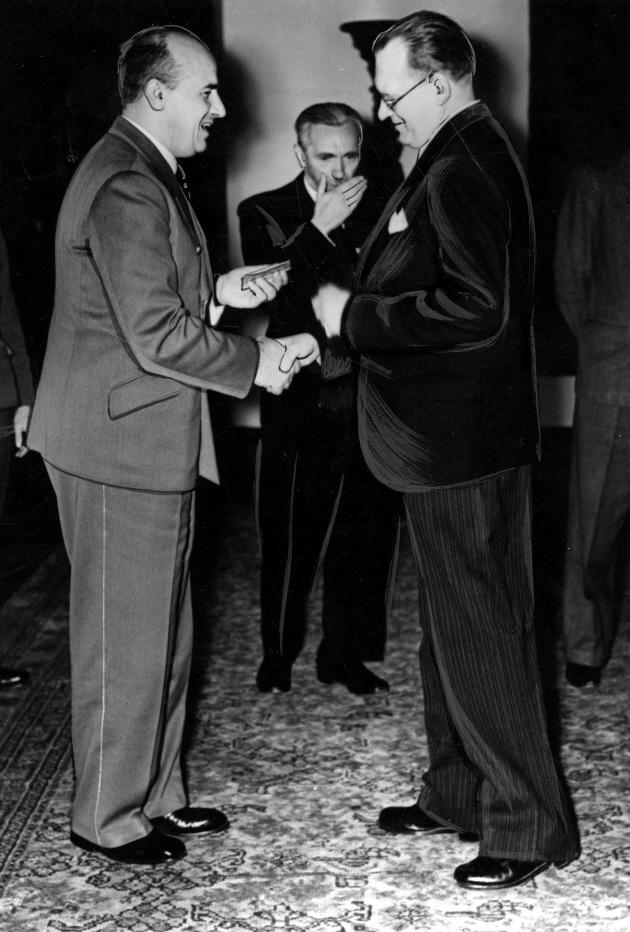

Only a limited number of copies of this exceptional (and, we understand, inexpensive) book are available, and we shall be pleased to forward to the author any messages from readers who wish to buy it.
8205. Réti v Capablanca, New York, 1924
From page 105 of The Amazing Book of Chess by Gareth Williams (Godalming, 1999), in the section on Capablanca:
‘His losses became so rare that on one occasion the front page headline of the New York Times read “Capablanca Loses”.’
That sounds even more dramatic than what Harold C. Schonberg wrote on page 166 of Grandmasters of Chess (Philadelphia and New York, 1973):
‘At the New York, 1924 tournament he lost to Réti. So unexpected was that loss, so unbeatable had Capablanca been, that the New York Times commemorated Capablanca’s loss in a headline: CAPABLANCA LOSES/1ST GAME SINCE 1914. (The Times for once was inaccurate, for Capablanca had lost a game to Chajes in New York in 1916.)’
So, just how eye-catching was the newspaper’s front-page story on 23 March 1924, the day after the Cuban’s loss to Réti?
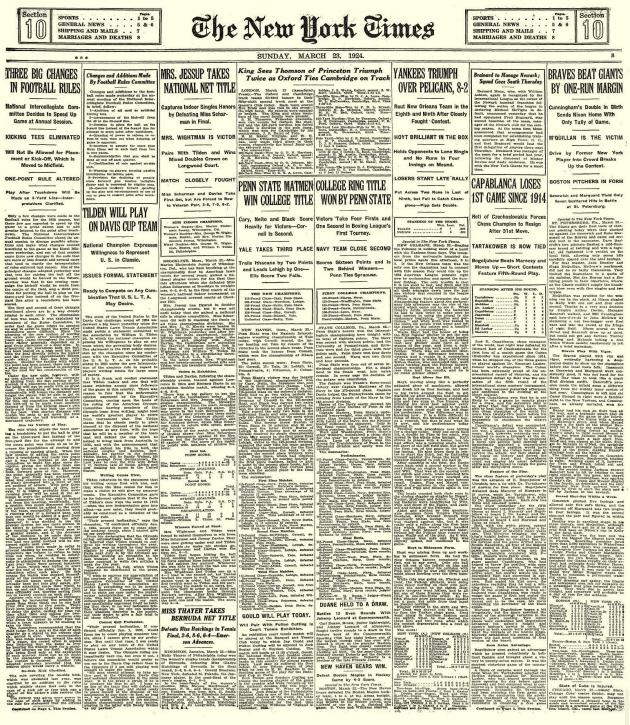
Contrary to the statement in the New York Times, the Cuban’s unbroken run (apart from the loss to Chajes in 1916) stretched back to his defeat by Tarrasch, and not Lasker, at St Petersburg, 1914.
8206. The gentle art of swindling (C.N. 8179)

Play went 1...Ng4 2 Qg8+ Kg6 3 Qe6+ Kh7 4 Qg8+ Drawn. No further details have yet been traced concerning this nineteenth-century game involving R. Hoffers.
However, Richard Forster (Zurich) considers that the Horowitz and Reinfeld book was incorrect to classify the play as a ‘swindle’. There was no element of luck, such as a move or plan which worked only because the opponent did not see through it in time. Both sides simply played the best moves, and the spectacular draw by perpetual check was the fair outcome.
Our correspondent adds that Black’s unknown move before Rf5-c5 could be called a swindle if it provoked White to err with the move Rf5-c5, but that was not the thrust of Horowitz and Reinfeld’s text.
8207. Golombek v Price
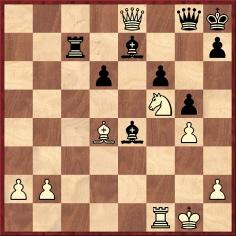
From pages 166-167 of Beginning Chess by Harry Golombek (Harmondsworth, 1981):
‘This is a variation from a game, Golombek-H.E. Price, Hastings, 1932-33, for which White was awarded a brilliancy prize. White now plays 1 NxB, and after 1...QxQ 2 BxP mate. The perfect co-operation between bishop and knight has enabled White to dispense entirely with his queen.’
The event was the Premier Reserves tournament, but we have yet to find the game-score.
8208. Photographs (C.N. 8204)
Wolfgang Franz (Oberdiebach, Germany) notes that the photographs in C.N. 8204 can be viewed, together with many others, at the Polish Zbiory NAC online website, e.g. by searching for Szachowe or Alechin.
8209. Excelsior
Wanted: more information about a game whose conclusion was on page 51 of Das Matt by Kurt Richter (Berlin, 1942):

8210.
Excelsior (more over-the-board examples)
Concerning the excelsior theme in over-the-board play, Michael McDowell (Westcliff-on-sea, England) writes:
‘There are two examples on page 192 of A.J. Roycroft’s Test Tube Chess (London, 1972): “Erler v Altwein, East German Junior Championship, 1969” and “H. Westerinen v Y.E. Westman, Uppsala, 1969”.
The earliest known specimen is Shumov v Jaenisch (Deutsche Schachzeitung, May 1850, pages 175-176).’
Another case is Ozols v Hasenfuss, Kemeri, 1937. A further example comes in a game between Edward (then Eduard) Lasker and Herbert Jacobs in the City of London Chess Club Championship, 1, 5 and 6 February 1913:

96...h5 96 Kd6 h4 97 Kxc6 h3 98 Kd7 h2 99 c6 h1(Q) 100 c7 Qb7 101 Kd8 Kf6 102 Kd7 Ke5 103 Kd8 Kd6 104 c8(N)+ Ke6 105 White resigns.
Sources (full game-score): BCM, March 1913, pages 113-115, and Wiener Schachzeitung, February-May 1914, pages 125-128.
Below is a game which Julian Hodgson annotated enthusiastically on pages 124-125 of his book Attack with G.M. Julian Hodgson (London, 1996):
Patrick Yee – Julian Hodgson
New York Open, 1995
King’s Fianchetto Defence
1 e4 g6 2 d4 Bg7 3 Bc4 c5 4 c3 cxd4 5 Nf3 d6 6 cxd4 Nf6 7 Nc3 O-O 8 Bb3 Bg4 9 h3 Bxf3 10 Qxf3 Nc6 11 Be3 Nd7 12 Qd1 Na5 13 O-O Nb6 14 Qe2 Rc8 15 Rfd1 Nbc4 16 Bg5 a6 17 Rd3 b5 18 Rad1 Re8 19 Bc1 e6 20 Qg4 Nxb3 21 axb3 Na5 22 Ne2 Rc2 23 Bg5 Qa8 24 R1d2

24...f5 25 Qh4 fxe4 26 Rxc2 exd3 27 Rc7 dxe2 28 Bf6 e1(Q)+ 29 Kh2

29...Qb7 30 White resigns.
8211. The hedgehog formation (C.N. 7574)
Brian Karen (Levittown, NY, USA) adds a citation from page 69 of 500 Master Games of Chess by S. Tartakower and J. du Mont (London, 1952):
‘In this, the normal position of the Steinitz Defence, Black occupies a “hedgehog” formation. All his minor pieces are in a state of expectant defence. White has now a large choice of good continuations, but none likely to upset Black’s defensive formation.’
The note came after 1 e4 e5 2 Nf3 Nc6 3 Bb5 Nf6 4 O-O d6 5 d4 Bd7 6 Nc3 Be7 7 Re1 exd4 8 Nxd4 O-O in Tarrasch v Lasker, second match-game, 1908.
The image of a curled-up hedgehog was used by Nimzowitsch on pages 70 and 115 of Die Praxis meines Systems (Berlin, 1930); see pages 100 and 163 of The Praxis of My System (London, 1936).
On page 202 of the September 1937 Chess Review Paul Hugo Little wrote regarding the game Pipiringos v Hahlbohm, Chicago, 1937:
‘[Pipiringos] got himself into a weird position resembling one of Steinitz’s hedgehog defenses, and quickly lost.’
8212. Gold coins
The mystery of the Marshall ‘gold coins’ game is still proving impossible to unravel, but, more generally, below is a novel suggestion from page 79 of Play Chess by William Hartston and Jeremy James (London, 1980):
‘In the old Viennese coffee-houses where chess was played many years ago, the spectators used to admire brilliant sacrifices so much that they would shower the board with gold coins for the winner.’
8213. Five queens
Headed ‘The Mythical “Five Queens’ Game”’, an item by D.J. Morgan on page 130 of the May 1956 BCM began:
‘The ghost has been truly laid ...’
He was reporting on a series of articles by Albrecht Buschke in Chess Life in 1950 which had demonstrated that the ‘five queens’ play given by Alekhine in a note to Game 26 in his first volume of Best Games was spurious.
C.N.s 326 and 387 touched on the matter, and since then it has been analysed in detail by Tim Krabbé, on pages 54-64 of Chess Curiosities (London, 1985) and on his website. The case is regularly cited as an example of Alekhine’s ‘dishonesty’.
How is it possible that, even today, there are authors who state that Alekhine won such a game? The latest instance noted by us is on page 381 of Best Play by Alexander Shashin (Newton Highlands, 2013).
8214. Capablanca v Price/Baca-Arús
Page 365 of A. Shashin’s Best Play has a position headed ‘Capablanca-Baca, La Habana (blindfold), 1912’.
The game-score is well known from its inclusion in, for instance, Modern Ideas in Chess by Richard Réti (London, 1923), Meet the Masters by Max Euwe (London, 1940) and The Immortal Games of Capablanca by Fred Reinfeld (New York, 1942). From page 102 of the Euwe book:
‘Such an achievement in the realm of combinative chess can only be described as superb.’
However, the game requires careful handling in view of the complications set out by David Hooper and Dale Brandreth on pages 111-112 of The Unknown Capablanca. Below is the relevant section from the second, revised edition of their book (New York, 1993):

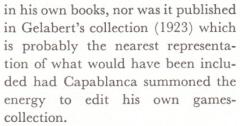
The game’s appearance on page 9 of Capablanca-Magazine, 25 April 1912, under the heading ‘Blindfold Chess’:

The game-score has not been found in either of the two Cuban newspapers of the time which were notable for their chess content, Diario de la Marina and La Discusión. Page 46 of our book on Capablanca briefly referred to the game, mentioning that when Brian Harley published it on pages 16-18 of Chess and Its Stars (Leeds, 1936) he wrote: ‘Capablanca’s comment to me is: “I can’t play games like that now!”’
Baca-Arús was not named when the game was given in the Euwe, Harley, Reinfeld and Réti books or, for example, in Homenaje a José Raúl Capablanca (Havana, 1943). Nor did the word ‘blindfold’ appear. The same applies with regard to the full page (page 232) which the tactical play received in Combinations The Heart of Chess by Irving Chernev (New York, 1960). With the exception of Harley’s book, all these works broke off the game after White’s 22nd move. Harley continued to move 25 but with a different finish from that given in Capablanca-Magazine and The Unknown Capablanca: 22...Nd8 23 Qh8+ Kf7 24 Qg7+ Ke6 25 Nf8+ Resigns.

Jaime Baca-Arús (American Chess Bulletin, May 1912, page 106 and June 1912, page 136)
The Capablanca v Price game (Birmingham, 24 November 1911) referred to in The Unknown Capablanca appeared quite widely at the time, e.g. on page 19 of the Cheltenham Looker-On of 2 December 1911, which reproduced the notes of the Birmingham Daily Post:
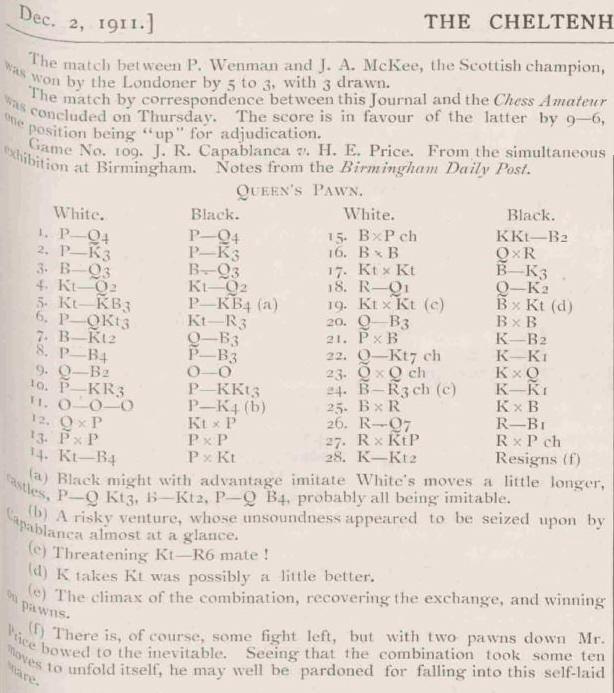
An especially interesting column is Gunsberg’s on page 5 of the Manchester Guardian, 5 December 1911 because it pointed out the possibility of 19 Rd7, the spectacular move that occurred in Havana the following spring in the game against Baca-Arús:
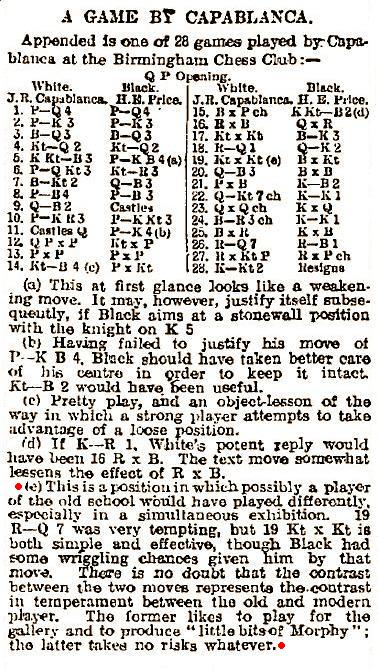
The report on the Birmingham display on pages 23-24 of the January 1912 BCM included the following:
‘Mr H.J. Whitlock, a member of the club, and head of one of the leading photographic firms in the city, secured an excellent series of portraits prior to the Señor’s early departure for London the following day.’
8215. A baby’s smile
‘It seems that Fine once wrote that in such positions a combination is as natural as a baby’s smile.’
So wrote Valery Salov on page 21 of the 5/1989 New in Chess regarding 19 Nxe6 in Kasparov v Salov, Barcelona, 1989. Salov’s remark is quoted on page 258 of Garry Kasparov on Garry Kasparov Part II: 1985-1993 (London, 2013) in a slightly different wording (‘I think it was Reuben Fine who wrote ...’).
It was indeed Fine, on page 195 of the June-July 1943 Chess Review:

The game was Rellstab’s victory over Alekhine at Munich, 1942, although in the heading (page 193) Fine put ‘Monaco’, an error corrected when the article was reproduced on pages 135-141 of his book Chess Marches On! (New York, 1945).
Rellstab’s annotations to the game were published on pages 142-143 of Deutsche Schachblätter, 1 October 1942. The 1 August 1942 issue (page 119) had a photograph of him in play (left) against Schmahl at Bad Oeynhausen, 1942 (‘Schachmeisterschaft von Großdeutschland’):

8216. Enliveners and grief savers
From page 79 of the April 1939 Chess Review:
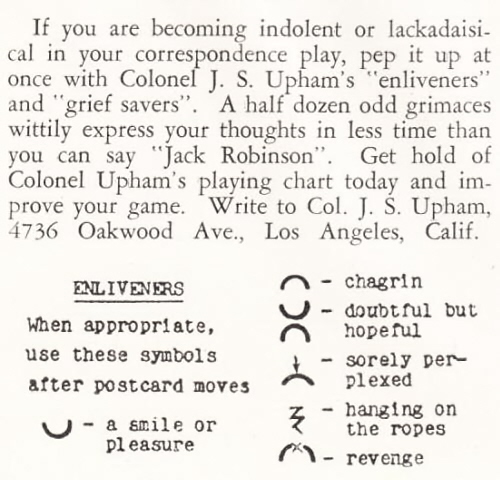
8217. Réti v Capablanca, New York, 1924 (C.N. 8205)
C.N. 8205 showed the report of Capablanca’s loss to Réti on the front page of the sports section of the New York Times, 23 March 1924.
There was no mention of the game on the newspaper’s very front page.
8218. Counter-attack (C.N. 3038)
Further to C.N. 3038 (see page 325 of Chess Facts and Fables), we still hope to find corroboration of a quote included by Vera Menchik at the start of an article, ‘How to Meet an Attack’, on pages 479-482 of the Social Chess Quarterly, January 1935:
‘“Counter-attack is the soul of the game”, said Blackburne, and all the authorities agree that counter-attack is the best possible defence.’
Vera Menchik further endorsed the sentiments in the final paragraph of her article:
‘And so once more we repeat: counter-attack is the soul of the game, and it is the best possible defence ...’
8219. Passenger lists
From John Townsend (Wokingham, England):
‘Some UK Incoming Passenger Lists (1878-1960) have recently been indexed.
There are records of eight occasions when Capablanca arrived in England: 14 February 1911 (Liverpool), 10 October 1913 (Southampton), 2 August 1919 (Southampton), 19 October 1925 (Southampton), 26 March 1929 (Southampton), 11 June 1931 (Plymouth), 23 December 1934 (Liverpool) and 10 April 1936 (Plymouth). On arrival in 1934 he gave as his address in the United Kingdom the Cuban Legation, 30 York Terrace, London NW1.
When Alexander Alekhine arrived at Southampton on 19 April 1938 he was accompanied by Grace Alekhine, whose age was given as 51. They had come from Buenos Aires, and both were listed as residents in France. The address specified in the United Kingdom was the Grand Hotel, Cliftonville, Margate.
There is also a record of the arrival of H.N. Pillsbury in Liverpool in May 1898. His occupation was given as “Theatrical”.’
8220. Arthur Tartakower (C.N. 8198)
Tomasz Lissowski (Warsaw) reports that Arthur Tartakower is buried in Kotowice Cemetery.
Source, found by Marek Lis (Opoczno, Poland): page 251 of Wielka Wojna na Jurze by P. and K. Orman (Cracow, 2008).
8221. A baby’s smile (C.N. 8215)
C.N. 8215 quoted a remark by Reuben Fine on page 195 of the June-July 1943 Chess Review: ‘In such positions combinations are as natural as a baby’s smile.’
In a supplement (‘Abracadabra Chess’ by Larry Evans) to the Fall 1962 issue of the American Chess Quarterly the following appeared on page 333, concerning Morphy v the Duke and Count:
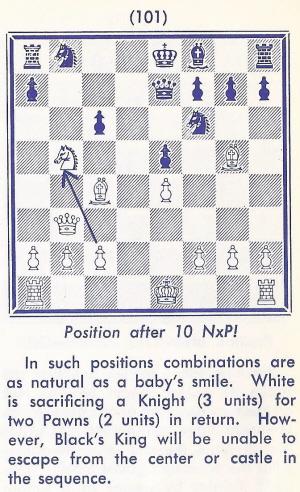
Evans had a habit of lifting other writers’ bons mots and prose for presentation as his own. For example, on page 71 of Guide to Good Chess (Sydney, 1950) C.J.S. Purdy wrote:
‘Pawn endings are to chess what putting is to golf, with the big difference that they do not occur in every game.’
Two misappropriations:
- ‘Endgames are to chess what putting is to golf.’
L. Evans, on page 270 of Chess Life & Review, May 1970.
- ‘Pawn endings are to chess what putting is to golf.’
L. Evans, on page 29 of Evans on Chess (New York, 1974).
The Facts about Larry Evans quotes four publications where he gave as his own work a 50-word passage about Rubinstein which had been written by Irving Chernev.
Our article also shows that page 45 of Evans’ book The 10 Most Common Chess Mistakes (New York, 1998) has the following mistakes:
‘Thomas – Mitchell’; Black’s name was Michell.
‘London, 1932’; the game was played at the Hastings, 1932-33 tournament.
Wrong diagram, since the pawn at c5 should be black.
In his paragraph (a) Evans omits mention of the faster win 5 Re7+.
In his paragraph (b) he writes ‘Black actually lost’, whereas Black actually won.
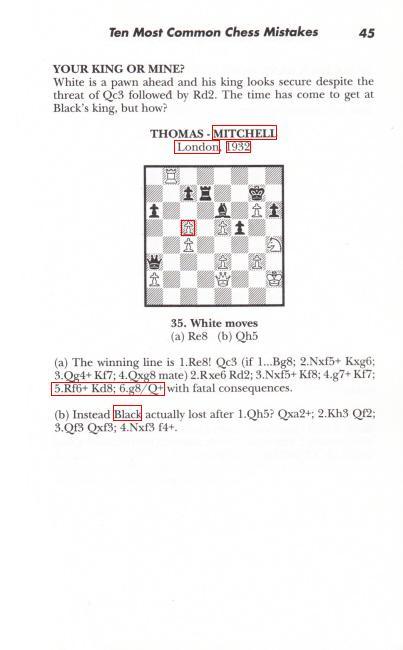
In this position there are errors by Evans which duplicate what was on page 317 of The Personality of Chess by I.A. Horowitz and P.L. Rothenberg (New York, 1963).
Nonetheless, on page 34 of The Chess Beat (Oxford, 1982) the same Larry Evans wrote that Reuben Fine’s Basic Chess Endings was ‘riddled with errors’ and proclaimed:
‘The essential problem is that opinions are often copied uncritically and perpetuated in the textbooks. Error is passed from hand to hand, like a torch.’
8222. From hand to hand
Page 42 of Evans on Chess by Larry Evans (New York, 1974):

As regards the final paragraph, at the time of his death,
in late December 1918, Schlechter was by no means
‘forgotten’; he was the Editor of the Deutsche
Schachzeitung and in September-October 1918
had participated in a double-round tournament in Berlin
with Lasker, Rubinstein and Tarrasch. His death occurred
not ‘in the last year of World War I’ but after the War
was over. Nor was he found dead alone in his room at home
(which would mean in Vienna); he died in hospital in
Budapest. The cause of his death is uncertain. He was then
aged 44, not 35.
That syndicated column by Evans, riddled with errors though it was, was still appearing in newspapers nearly 15 years after its first publication (on, for instance, page D27 of the Chicago Tribune, 3 May 1987), without even a correction of Schlechter’s age.
Nor, of course, was there ever an admission that the article was heavily reliant on a piece about Schlechter by Heinrich Fraenkel published on pages 50-53 of Chess Treasury of the Air by Terence Tiller (Harmondsworth, 1966) and reprinted on pages 5-6 of the January 1970 Chess Digest. Below is the final paragraph from the book:
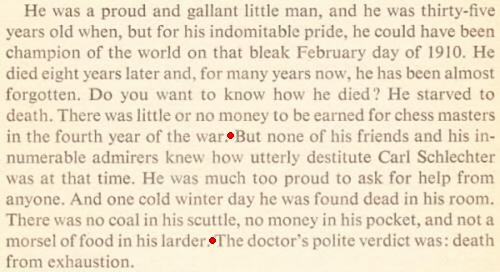
It is obviously unwise to rely on such material without independent corroboration, but Evans relied on it without even reading it properly. Fraenkel stated, correctly, that Schlechter was aged 35 at the time of the match against Lasker, and not when he died, and he referred to Schlechter being almost forgotten ‘for many years now’ (i.e. from the standpoint of the mid-twentieth century), and not at the time of his death.
Despite cribbing from Fraenkel, Evans contradicted him concerning the terms of the Lasker v Schlechter match (for Fraenkel was the ‘critic’ mentioned anonymously three paragraphs from the end of Evans’ article). He also wrote simplistically and categorically about the match on page 49 of The Chess Beat, again with no apparent understanding of what is one of the most complex puzzles in chess history. It is not by chance that criticism of Evans’ published output increased during his later years, as he eschewed writing about chess play (in which he held the grandmaster title) and preferred writing about chess history, lore and politics (in which he held himself up to ridicule).
On pages 45-50 of Carl Schlechter! Life and Times of the Austrian Chess Wizard (Yorklyn, 1994) Warren Goldman discussed Schlechter’s demise in detail, noting that possible causes of death were lung disease aggravated by lack of proper nutrition, tuberculosis, pneumonia and the Spanish flu epidemic. On page 46 he wrote:
‘Published accounts concerning the medical details are fragmentary and do not allow a firm conclusion as to the precise cause of death.’
Pages 428-452 of the Goldman book sifted the evidence regarding the conditions for the 1910 Lasker v Schlechter match. Again, no definitive conclusions could be offered.
That is how proper writers (not only historians, of course) work. When they know, they explain why they know. When they are uncertain, they explain why they are uncertain. When they do not know, they either say that they do not know or they say nothing. That is honest writing which treats the reader with respect, and there is no other kind worth doing.
8223. Alekhine article
Javier Asturiano Molina (Murcia, Spain) notes a passage on page 82 of Half a Century of Chess by Mikhail Botvinnik (Oxford, 1984):
‘There, in England, I finally gained international recognition, and after the tournament [Nottingham, 1936], on the pages of Manchester Guardian, Alekhine declared that Botvinnik had every chance of becoming world champion.’
Our correspondent asks if Alekhine’s exact words can be found.
The article was published on pages 13-14 of the Manchester Guardian, 29 August 1936, and the full text is given below:

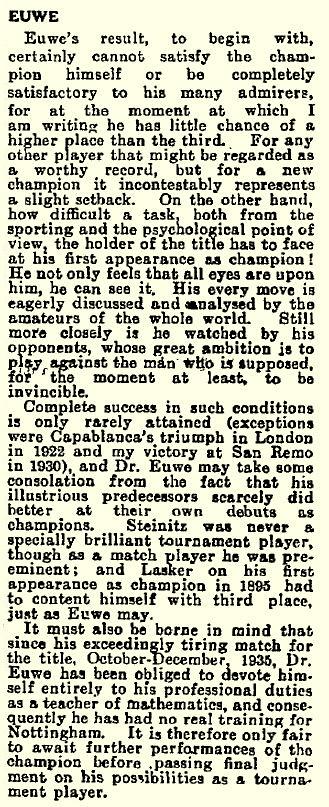
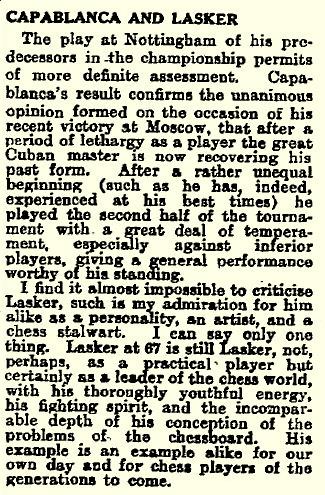
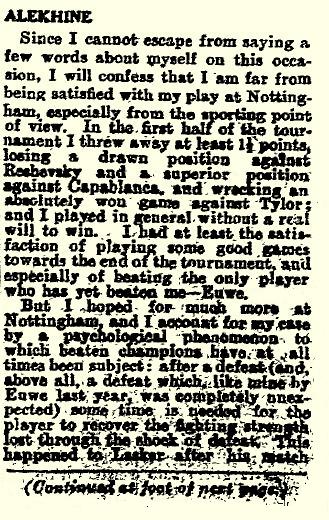
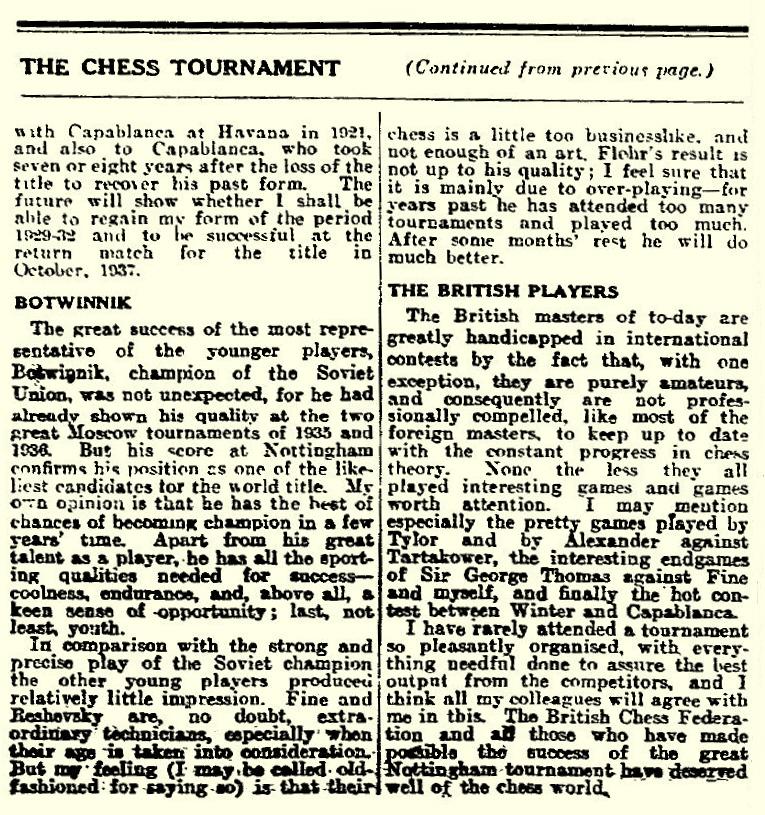
8224. Evelyn Waugh
Alan McGowan (Waterloo, Canada) quotes from page 275 of the December 1943 BCM:
‘We are informed by B.S. Brown, now an officer in the RAF temporarily in Canada, that a village chess club at Charfield is flourishing. It was founded in 1933. Its list of 39 members contains many prominent names, among them Mr Evelyn Waugh, now on active service. The proportion of members on active service is very high, more than a third in fact.
It would be interesting if Mr Waugh would write a report on this interesting club, which is, quite probably, the largest village club in existence.’
8225. Internet
booksellers
Ryan Paulis (Amsterdam) notes the high prices being charged on the Internet for No Regrets by Y. Seirawan and G. Stefanovic (Seattle, 1992). On abebooks.com a vendor in Merchantville, NJ, USA is asking $1,250 for the hardback edition in ‘very fine’ condition.
The original price of the book, published in December 1992, was $34.95 (or $24.95 for the softback edition).

Back cover of the 25 January 1993 issue of Inside Chess
No Regrets, by far the best book on the 1992 Fischer v Spassky match, is indeed hard to come by nowadays, but there is little logic in chess book prices on the Internet. C.N.s 2308 and 2329 (see page 149 of A Chess Omnibus) touched on the subject, although mainly in the context of signed works.
Here we add, at random, the example of a fairly recent book. A mint copy of the paperback edition of Samuel Reshevsky by Stephen W. Gordon can be bought direct from McFarland & Co., Inc. for $45, whereas a second-hand copy is being offered on abebooks.com for nearly $230 by a Texas bookseller (named ‘ExtremelyReliable’).

General dealers may cause inflation by copying, or worse, each other’s prices, regardless of considerations of quality or scarcity. Given this indiscriminate greed, with many a wet finger in the wind, no self-respecting author would boast about how much is being charged for his books by such people.
8226. My 60 Memorable Games
From page 65 of the February 1969 Chess Life:
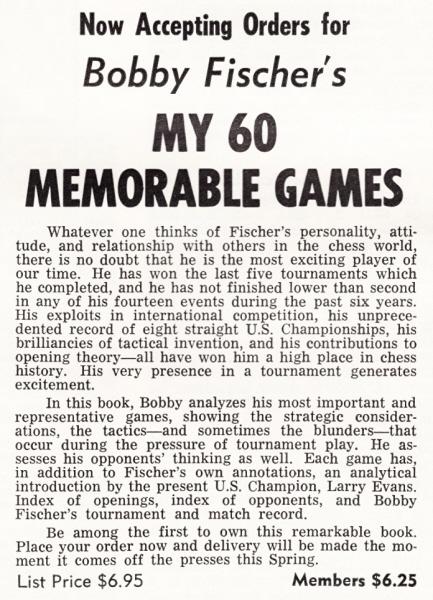
The availability of Fischer’s book in the United States Chess Federation’s inventory was announced on page 150 of the April 1969 Chess Life, and the magazine’s Editor, Burt Hochberg, wrote a detailed review on pages 235-236 of the June 1969 issue.
But what about the United States’ other major chess magazine of the time, Chess Review (Editor: I.A. Horowitz)? We have searched in vain throughout the 1969 volume of Chess Review for the slightest mention of My 60 Memorable Games. Why was it ignored?
8227. Morphy, fishing and the Indian Problem
At the end of an article marking the death of William Robert Inge Dalton (pages 132-134 of the July-August 1931 American Chess Bulletin) Henry W. Barry quoted a letter received from Dalton (which appeared with some erroneous French):
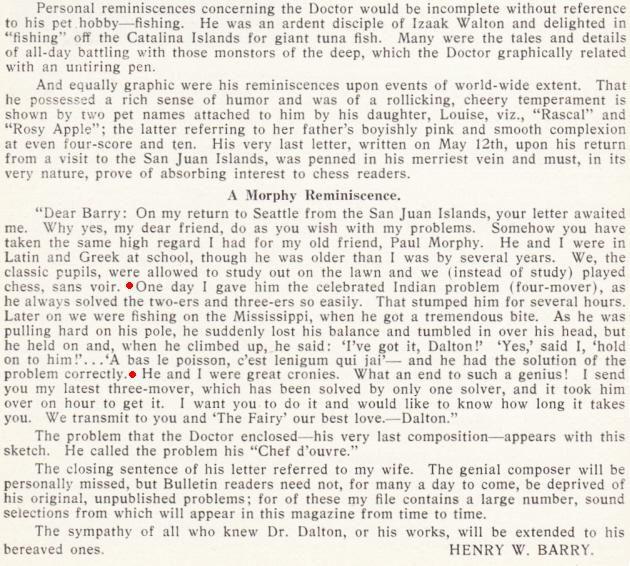
Referring to the letter, James Barrett commented on page 55 of the February 1981 BCM:
‘The late lamented David Lawson had no time for the garrulous Dr Dalton’s Morphy “reminiscences”, dismissing them pretty much out of hand, but the topic was discussed by him in the course of the 30 years’ correspondence we carried on about Morphiana.’
8228. Sämisch at Büsum and Lidköping
Chess literature has many references to F. Sämisch’s results at Büsum (Germany) in May 1969 and at Lidköping (Sweden) in July-August 1969, and especially concerning the quantity of games he lost by exceeding the time-limit.
Can the key facts be summarized?
8229. The local Derby
Below is an extract (the first paragraph) from an article by G.H. Diggle published in the August 1983 Newsflash and reproduced on pages 100-101 of Chess Characters (Geneva, 1984):
‘One hopes that the “Weekend Congress”, that great modern phenomenon which goes from strength to strength, will never entirely supersede the fine old Saturday “local Derby”. In particular, “Lincoln v Grimsby” will always be remembered with affection by the BM, especially the ham and tongue teas and the “on the spot” adjudications by the two match captains a few minutes before the last train home. In rough and ready manner was summary justice done, often based on material evidence alone rather than positional considerations. Not that “justice” always went unchallenged; there was one elderly bottom board who could argue with the persistence of a McEnroe and the ingenuity of a Jesuit. Apologetic match captain: “I’m sorry, Joe, we can’t possibly squeeze a draw for you out of this one. We might have overlooked a pawn or two, but you’ve lost a clear rook.” “That may be one way of looking at it, but don’t you see the darn rook was no use to me anyhow – I hadn’t even moved it.”’
8230. Boris Kostić in Mexico
Olimpiu G. Urcan (Singapore) forwards a game published by Louis van Vliet on page 5 of the Sunday Times, 12 July 1931:

C. Assisian (?) – Boris Kostić
Mexico (exact occasion?)
Queen’s Gambit Declined
1 d4 d5 2 Nf3 Nf6 3 c4 Bf5 4 Qb3 e6 5 Qxb7 Nbd7 6 Nc3 Rb8 7 Qxa7 Bb4 8 Bg5 O-O 9 e3 h6 10 Bxf6 Nxf6 11 Ne5 Ne4 12 Rc1 Ra8 13 Qb7 Bxc3+ 14 bxc3 Rxa2 15 Be2 Qg5 16 g3 Rfa8 17 h4 Rxe2+ 18 Kxe2 Ra2+ 19 Ke1 Qh5 20 f3 Nd2 21 Rh2
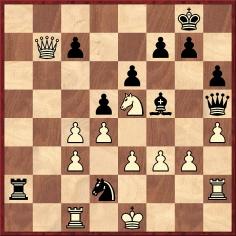
21...Qxf3 22 Nxf3 Nxf3+ 23 Kd1 Rxh2 24 Qa8+ Kh7 25 Ra1 Bd3 26 Kc1 Nd2 27 Qa4 Nxc4 28 Qd1 Be4 29 Qe1 Rc2+ 30 Kb1 Rxc3+ 31 Ka2 Ra3 mate.
When the game was published on pages 175-176 of Ambasador Šaha by D. Bućan, P. Trifunović and A. Božić (Belgrade, 1966) White’s name was given as ‘Asian’, and the heading also stated ‘Meksiko Siti, 1930’.
Page 112 of the July-August 1930 American Chess Bulletin reported that Kostić ‘is at present in Mexico City, where, we understand, he is fulfilling a six months’ engagement teaching chess to Mexican army officers’. His visit to Mexico City was also mentioned on page 149 of the September-October 1930 Bulletin. In December he travelled to St Louis in the United States for chess engagements (December 1930 issue, page 187).
8231. Youngest magazine editor
Who has been the youngest editor of a chess magazine?
In a letter to us dated 8 October 1983 Albrecht Buschke (New York) wrote:
‘Max Lange (1832-1899) was only 16 or 17 when he edited the Magdeburger Schachzeitung in 1849.’
The Magdeburger Schachzeitung can be read online.
8232. Buschke, Bigelow, Lasker and Fine
Pages 14-15 of the Winter 1980-81 issue of the Chess Journalist had an article by Albrecht Buschke about Horace Ransom Bigelow (1898-1980) entitled ‘Library of a Great Chess Journalist’. From page 14:
‘For the first American edition of Lasker’s Manual of Chess he compiled a very comprehensive index, which, strangely, in later editions was either suppressed or plagiarized without mentioning his name.
This collaboration with Lasker earned him a very warm handwritten dedication by the famous author reading:
“To one who co-operated with me on this book and who continued the tradition of my Evening Post column in brilliant style. To Horace Ransom Bigelow with kindest regards. Emanuel Lasker. New York, 19th of Sept., 1928.”
No higher praise from a competent authority can be imagined in connection with the famous chess column Bigelow conducted for decades in the New York Post, and this column, indeed, must be considered his greatest achievement.’
We are grateful to David DeLucia (Darien, CT, USA), who now owns the book, for permission to show the inscription:
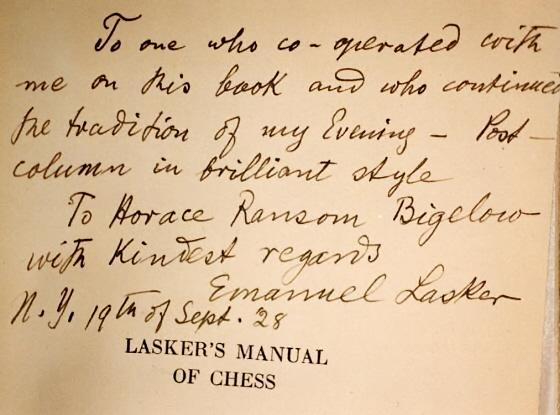
It is unclear which editions of the Manual Albrecht Buschke had in mind when referring to suppression and plagiarism. Bigelow was credited on page 377 of the original edition (published by E.P. Dutton & Company, New York in 1927), and on pages 375-376 he contributed an explanatory text entitled ‘Introduction to Index’. As regards the 1932 edition, published by Printing-Craft Limited, London, the text and index were different, and there was thus no reason for Bigelow to be mentioned. Later editions of the Manual (a revision by Reinfeld published by David McKay Company in 1947 and reprinted by Dover Publications, Inc. in 1960) are based on the 1932 edition.
The entry 10-172 on page 113 of Douglas A. Betts’ Chess An Annotated Bibliography of Works Published in the English Language 1850-1968 (Boston, 1974) concerns an edition of the Manual edited by Reuben Fine which is unknown to us:

Was it ever published?
8233. Differing views (C.N.s 6242 & 6567)
As shown in C.N.s 6242 and 6567, on page 17 of Why You Lose at Chess (New York, 1956) Fred Reinfeld commented:
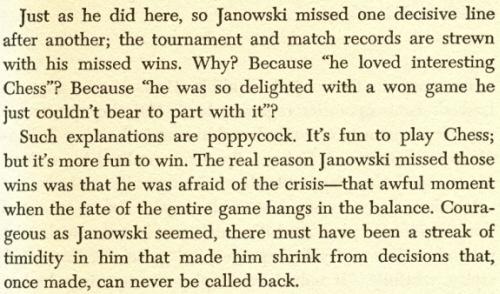 1
1Below is what Reinfeld wrote in ‘Emanuel Lasker: An Appreciation’ in his edition of Lasker’s Manual of Chess (Philadelphia, 1947):
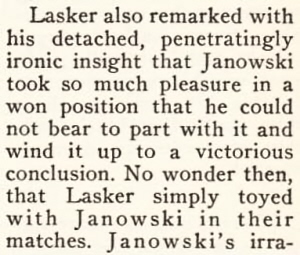
8234. The Prisoner (C.N.s 8143, 8146 & 8150)

C.N.s 8143, 8146 and 8150 discussed the episode ‘Checkmate’ in the 1967 television series The Prisoner, in which Patrick McGoohan wrote on a chess diagram in a newspaper:
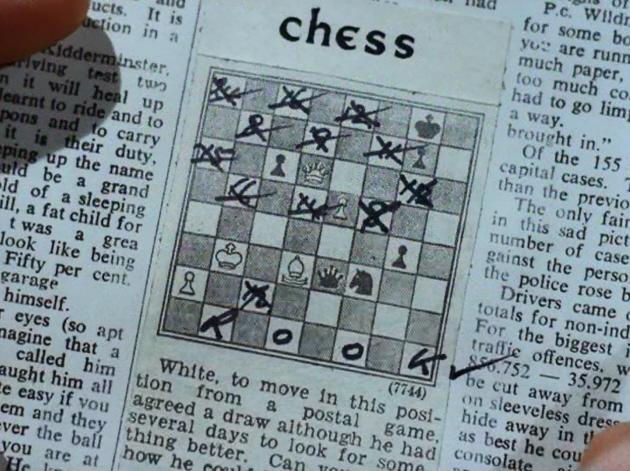
The column was recognizable as Leonard Barden’s in the London Evening Standard, and it was subsequently established that the position was from a correspondence game (Niels Lie v Arne Desler) played in the early 1930s.
The remaining loose end has been the date of publication in the Evening Standard, and we can now report that the position appeared on page 4 of the 9 January 1967 edition, with the solution given on page 8:
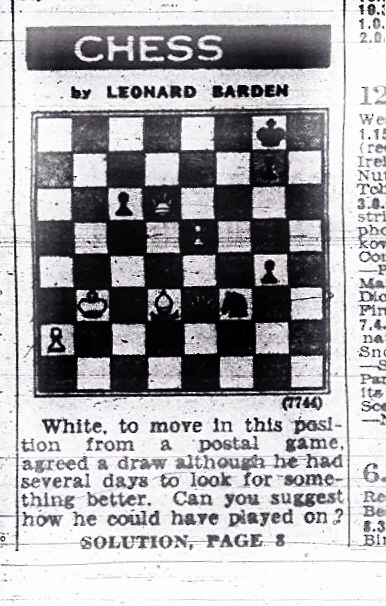

The sequence of C.N. items has now been brought together in a feature article, Chess and The Prisoner.
8235. Nice, 1925 (C.N. 3989)
C.N. 3989 gave a group photograph taken during the French Championship in Nice in September 1925. Another one was published on the Supplément page of the September 1925 issue of L’Echiquier:

A fine individual shot of Alekhine, apparently taken around the same time, may be seen at the Gallica website.
8236. Lasker’s Manual (C.N. 8232)
Rick Kennedy (Columbus, OH, USA) notes an entry at the website of the Cleveland Public Library under the heading ‘Reuben Fine Chess Collection’:
‘Fine’s revision of Emanuel Lasker’s Manual of chess published by Dutton in 1942 (27 cm.).’
We are grateful to the Library for permission to show here some sample pages of the work, which, it seems, was not published.
8237. Sämisch at Büsum and Lidköping (C.N. 8228)
Under the heading ‘For whom the bell tolls – 15 times’ Irving Chernev wrote on page 49 of Wonders and Curiosities of Chess (New York, 1974):
‘Sämisch lost all 15 of his games in a tournament held in Berlin in 1969. Others before him have lost every game they played in a tournament, but not in the way Sämisch did. He lost every game on time limit.’
‘Berlin’ should, of course, read Büsum.
Bent Kølvig (Rødovre, Denmark) notes that according to Bent Larsen’s report on the Büsum tournament on page 156 of the July 1969 Skakbladet, Sämisch lost all 15 of his games on time (‘probably a kind of world record’, Larsen commented) and participated only because a Bulgarian grandmaster did not arrive.
Below is the crosstable from page 155 of the Danish magazine:

Page 215 of the October 1969 issue gave the crosstable of the tournament in Lidköping:
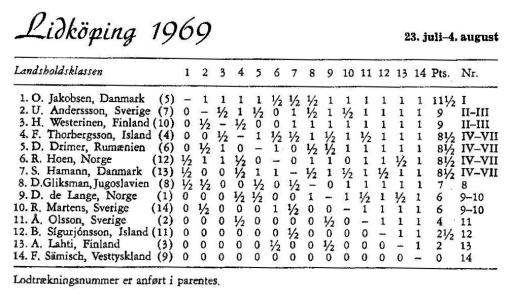
The accompanying report by Ole Jakobsen gave no details about Sämisch’s handling of the clock.
We note a brief item on page 180 of the August 1969 Tidskrift för Schack:

After referring to Sämisch’s performance in Büsum it states that in Lidköping he did not manage to make more than about half the requisite number of moves before, often in an equal or even superior position, he exceeded the time-limit. However, it is not specifically stated that he lost all his games on time.
8238. Max Fuller
(1945-2013)

Maxwell Leonard Fuller, Chess World, November-December 1965, page 131
Following the death of Max Fuller in Sydney on 27 August 2013, Mike Salter (Sydney) writes:
‘Is information available about one of the pivotal events in his chess career, the Hong Kong Zonal play-off in 1972? In the main tournament he finished in a three-way tie for second place with Tan Lian-Ann and Kan Wai-Shui (behind Torre), and the play-off among the three of them also ended in a tie. It is reported that lots were then drawn and that Tan went forward to the Petropolis Interzonal, also receiving the International Master title, while Fuller and Kan received nothing.’
An item from our collection (the Australian team at Nice, 1974):
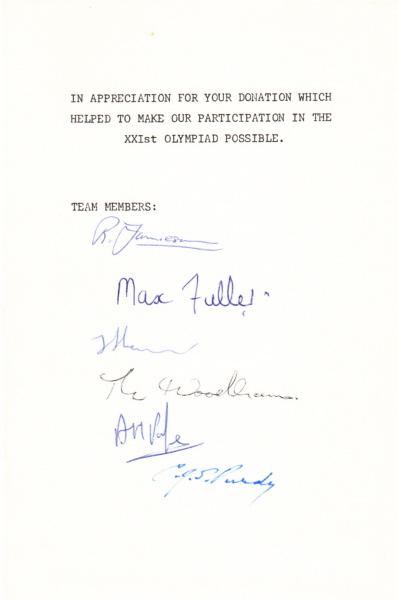
8239. Instructive

Did Capablanca play 40 h7 (rather than 40 Kf3)?
Later in the same game ...
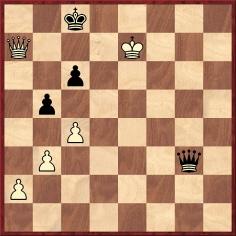
... did he blunder away his queen with 49 cxb5 (allowing 49...Qg7+, although Black missed the opportunity)?
To kill off, from the outset, any possible suspense, the answer to both questions is, of course, no. Indeed, the Cuban never played any game which reached remotely similar positions.
C.N. 3429 showed the finish of Capablanca v C.P. Dutt in a simultaneous display (+39 –0 =1) in Bristol on 9 October 1920 (Black having just played 26...f6):
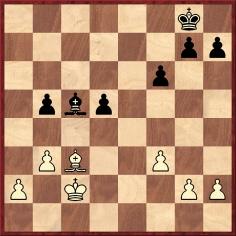
27 Kd3 b4 28 Bd4 Bd6 29 g3 Kf7 30 Bb6 Ke6 31 Kd4 Be5+ 32 Kc5 Bd6+ 33 Kc6 g5 34 Bc5 Bxc5 35 Kxc5 Ke5 36 Kxb4 Kd4 37 a4 Ke3 38 a5 d4 39 a6 d3 40 a7 d2 41 a8(Q) d1(Q) 42 Qe4+ Kf2 43 f4 Qd6+ 44 Kc4 Qa6+ 45 Kc5 Qa5+ 46 Kd6 Qb6+ 47 Ke7 Qxb3 48 Kxf6 gxf4 49 gxf4 Qc3+ 50 Qe5 Qc6+ 51 Qe6 Qc3+ 52 Kg5 Qg7+ 53 Kf5 Qf8+ 54 Qf6 Qc5+ 55 Kg4 h5+ 56 Kh4 Kf3 57 Qg5 Qf2+ 58 Qg3+ Qxg3+ 59 hxg3 Resigns.
Our source for the item, posted in 2004, was page 7 of the Western Daily Press, 11 October 1920:

The same newspaper item (though without the errors in the Forsyth notation) was published the same day on page 4 of the Bristol Evening News, and that was the source specified on page 365 of Capablanca in the United Kingdom (1911-1920) by Vlastimil Fiala (Olomouc, 2006):

‘27 Ke3 g4 28 Be4 Be6 29
b3 Kc7 30 Bd3 Kd6 31 Ke4 Bd5+ 32 Kf5 Be6+ 33 Kf6 b5 34
Bf5 Bxf5 35 Kxf5 Kd5
36 Kxg4 e4 37 h4 Kd6 38 h5 Kd7 39 h6 e3 40 h7 e2 41
h8(Q) e1(Q) 42 Qd4+ Kc7 43 c4 Qe6+ 44 Kf4 Qh6+
45 Kf5 Qh5+ 46 Ke6 Qg6+ 47 Ke7 Qxg3 48 Qxa7+ Kc8 49 cxb5
cxb5 50 Qc5+ Kb8 51 Qxb5+ 1-0.’
The ‘instructive’ nature of the episode lies elsewhere. Misled by how the press had used the Forsyth notation, Fiala gave a mirror-image of the initial endgame position (obviously wrong, since 26...c6 cannot occur when the Sicilian Defence has been played). The reflected image meant that the score had to be ‘corrected’ throughout, and when 36...K-Q5 was interpreted as 36...K-K5 a further error turned that alleged move (...Ke4) into ...e4. Despite subsequent guesswork it was naturally impossible to make sense of the remainder of the score, and at move 51 it was not Dutt who gave up but Fiala.
8240. Whimsy
On page 313 of the July-August 1934 issue of Les Cahiers de l’Echiquier Français Tartakower wrote that Barnes’ Opening (1 f3) could gain recognition if two ‘arbitrary’ chess rules were abolished: the double pawn-move and castling.
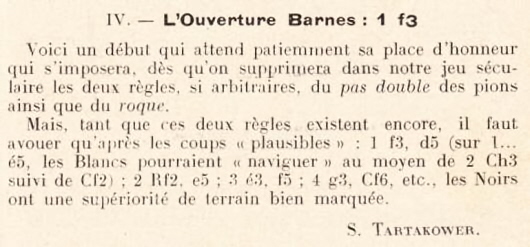
8241. Büsum, 1969 (C.N.s 8228 & 8237)
Miquel Artigas (Sabadell, Spain) writes:
‘I have checked the tournament booklet published by the Chess Player (undated but it appeared in 1969). On page 1 M.H. Horton states:“Sämisch still counts as an IM towards tournament classifications and so he was brought in as a last minute substitute. He made chess history by losing every game on time. Nevertheless, he achieved some good positions.”
The booklet includes all the games from the tournament, and after each of Sämisch’s it is specified that the loss was “on time”.’
8242. Lidköping, 1969 (C.N.s 8228 & 8237)
It is proving difficult to find particulars concerning Sämisch’s performance at Lidköping, 1969.
Calle Erlandsson (Lund, Sweden) notes a report on page 182 of the August 1969 Tidskrift för Schack that Sämisch overstepped the time-limit against Åke Olsson after only 12 moves.
8243. Barry v Hymes
A game to be added to Fast Chess comes from Eduardo Bauzá Mercére (New York, NY, USA). It was played in a rapid transit tournament (ten seconds per move) mentioned on page 182 of the April 1905 American Chess Bulletin.
John Finan Barry – Edward Hymes
New York, 14 April 1905
King’s Pawn Opening
1 e4 d6 2 d4 f5 3 Bd3 fxe4 4 Bxe4 Nf6 5 Bd3 Nc6 6 c3 e5 7 dxe5 Nxe5 8 Bc2 Be7 9 Ne2 O-O 10 O-O Nfg4 11 Bb3+ Kh8 12 h3 Nf6 13 Be3 Bf5 14 Nf4 Qe8 15 Nd2 Bd3 16 Nxd3 Nxd3 17 Qc2 Ne5 18 Rae1 Qh5 19 f4 Ng6 20 Nf3 Nh4 21 Nxh4 Qxh4 22 Bxa7 Nh5 23 Be3 Ng3 24 Rf3 Nf5 25 Bf2 Qh6 26 g4 Nh4 27 Bxh4 Bxh4 28 Ref1 Rae8 29 Qg2 Bd8 30 f5 Qg5 31 Be6 Re7 32 Qe2 Qh4 33 Kg2 h5 34 Rg3 Kh7 35 Qe4 Rf6 36 Qe1 Kh8
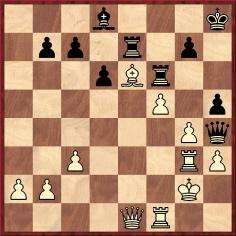
37 g5 Rf8 38 Qe2 Kh7 39 Qe3 Kh8 40 Kh2 Kh7 41 Kg2 Kh8 42 Qd4 Qxd4 43 cxd4 g6 44 d5 gxf5 45 Rgf3 Rg7 46 h4 Be7 47 Rxf5 Rxf5 48 Rxf5 Kh7 49 Kf3 Kg6 50 Rf4 Kh7 51 Ke4 Kh8 52 a4 Kh7 53 b4 Kh8 54 a5 Kh7 55 b5 Kg6

56 a6 bxa6 57 bxa6 Bxg5 58 hxg5 Kxg5 59 a7 Resigns.
Source: Brooklyn Daily Eagle, 28 May 1905, page 9.
8244. Capablanca in 1905
Mr Bauzá Mercére also forwards a report from the Brooklyn Standard-Union, 15 January 1905, page 6:
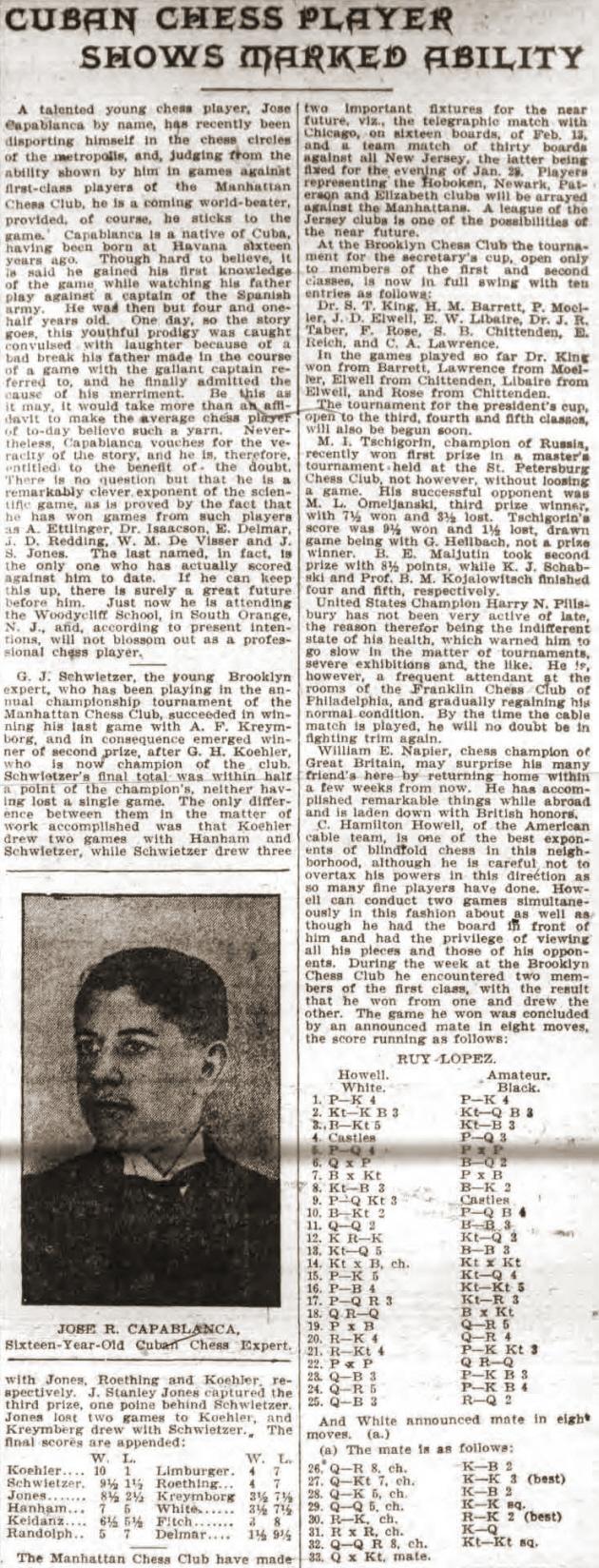
Later that year the photograph of Capablanca was published on page 126 of The Rice Gambit edited by H. Keidanz (an American Chess Bulletin Souvenir Supplement).
8245. C.P. Dutt (C.N.s 3429 & 8239)
Gene Gnandt (Houston, TX, USA) notes a webpage with detailed information on Clemens Palme Dutt (1893-1975).
| First column | << previous | Archives [109] | next >> | Current column |
Copyright: Edward Winter. All rights reserved.